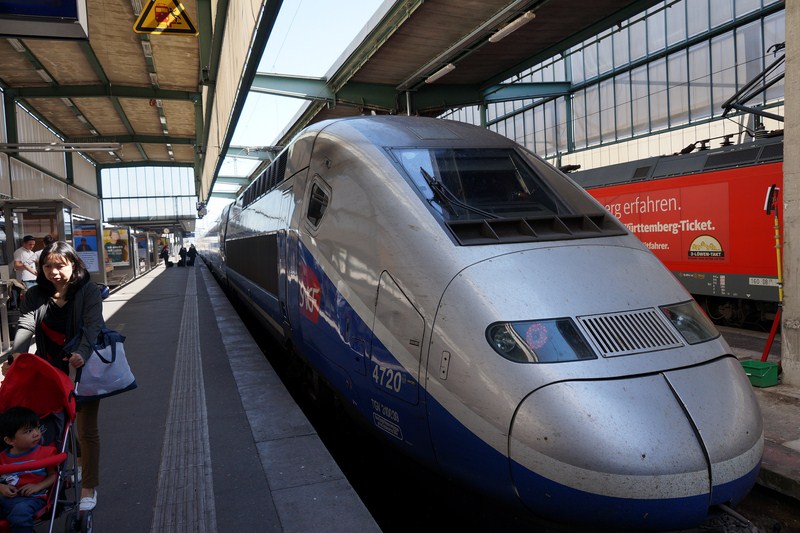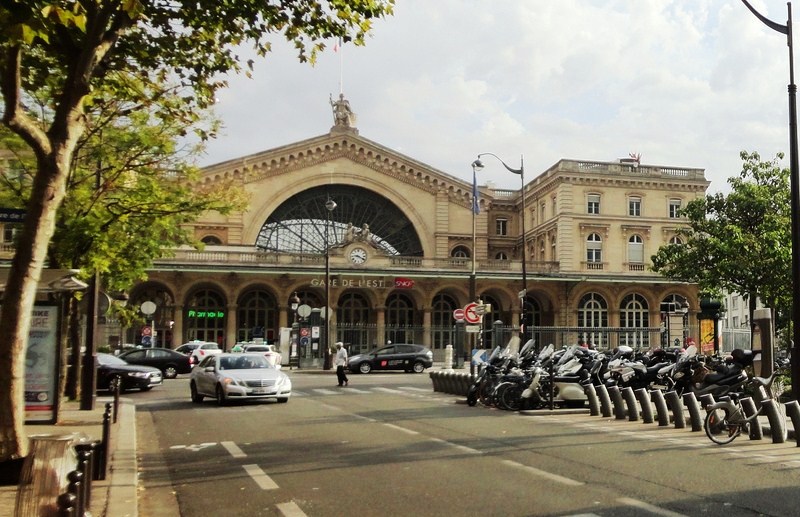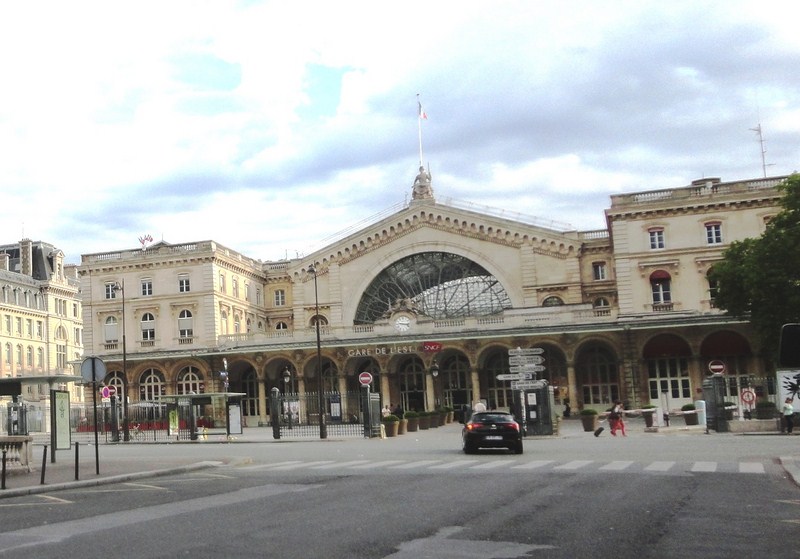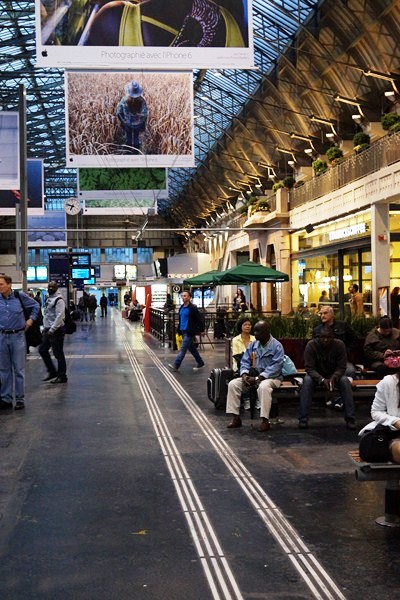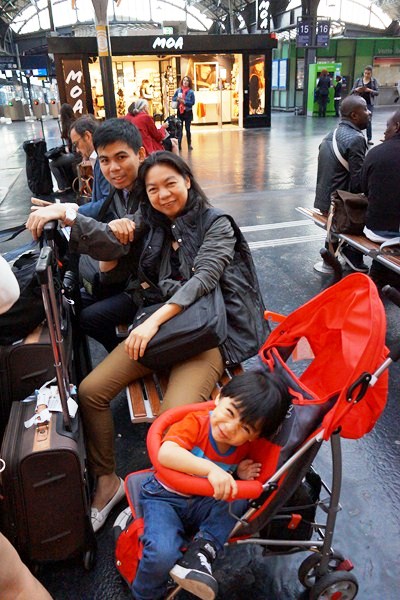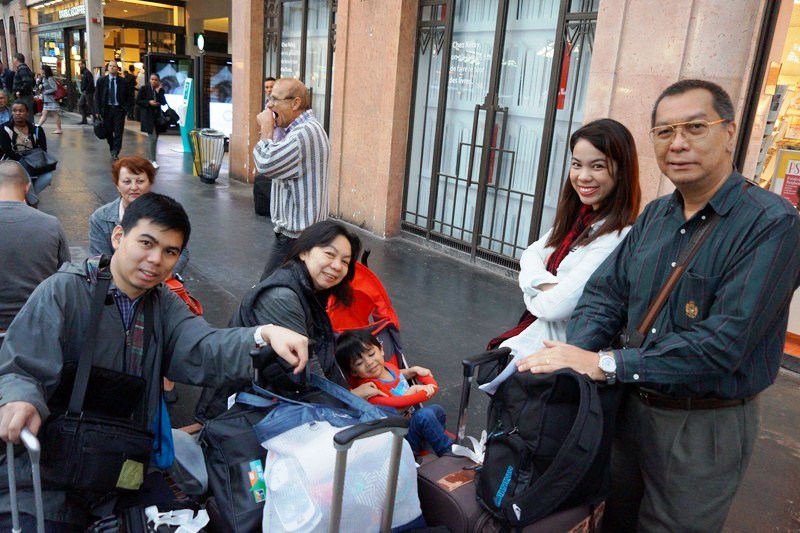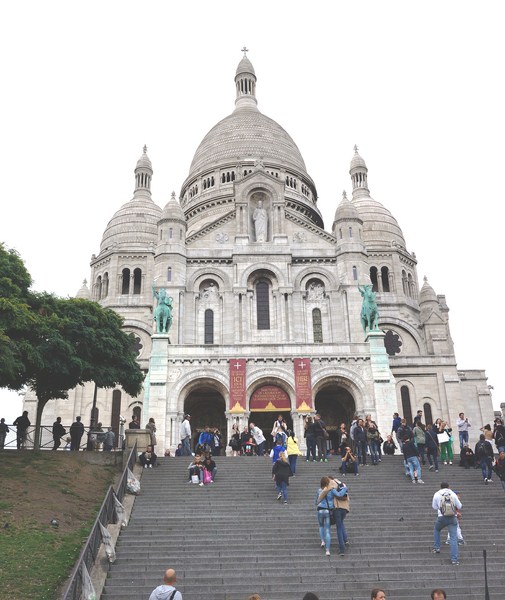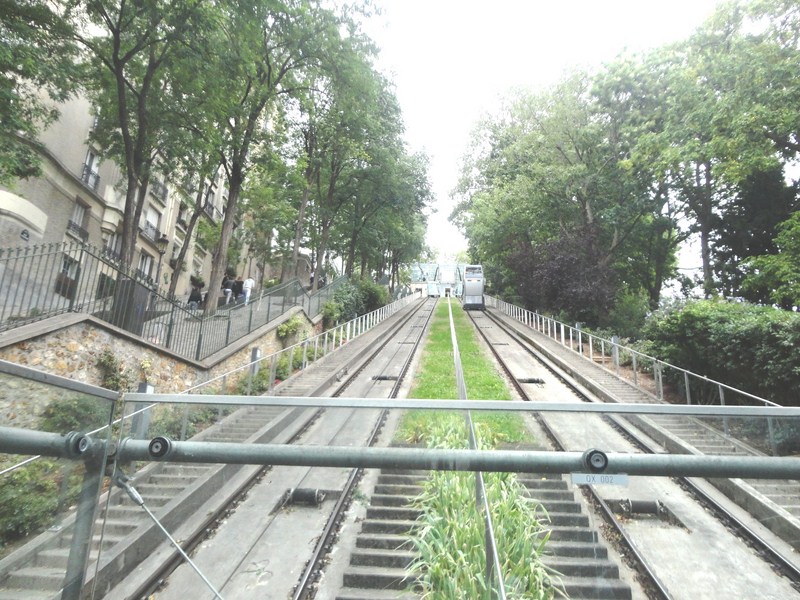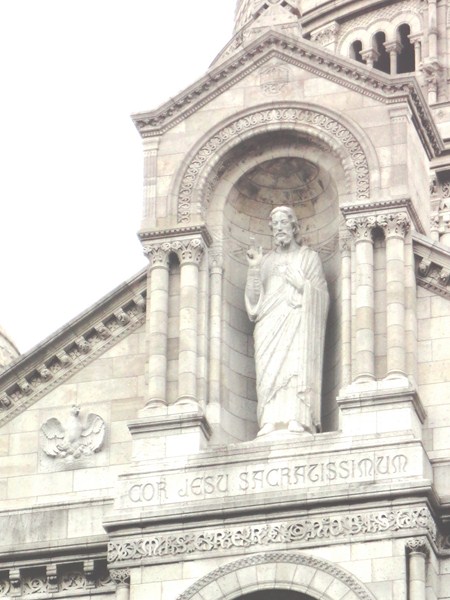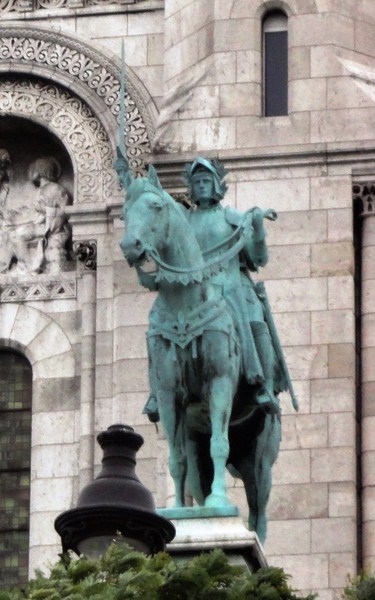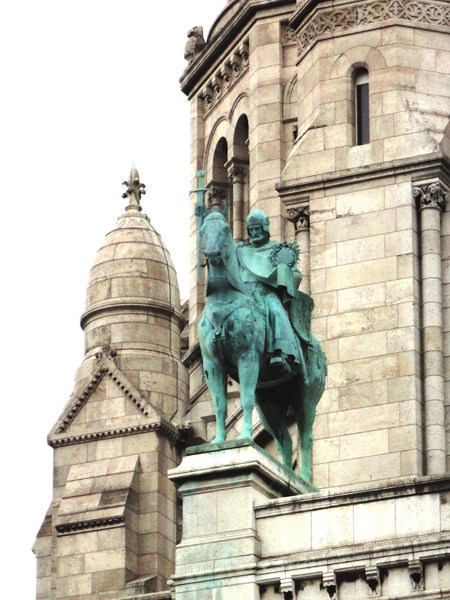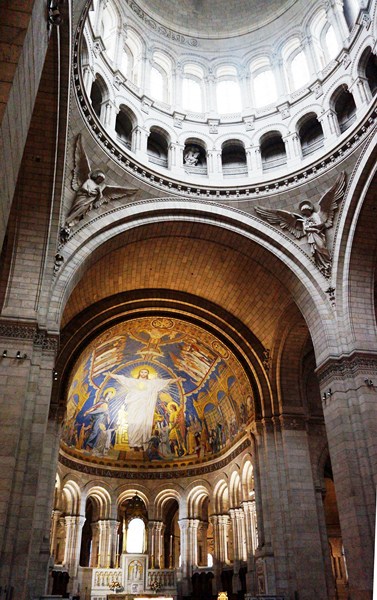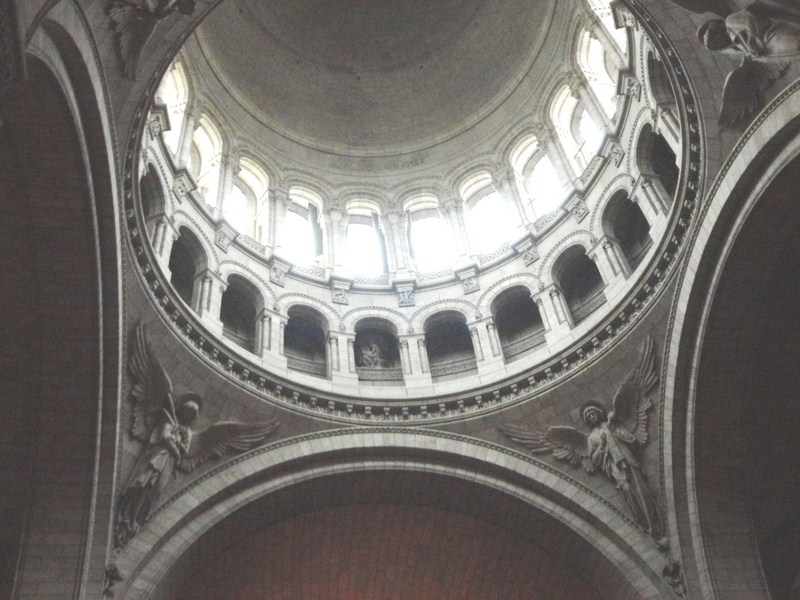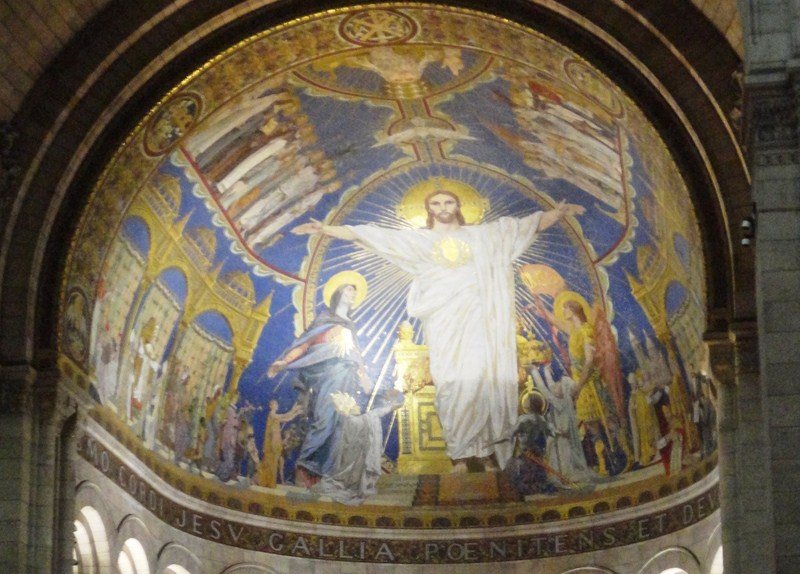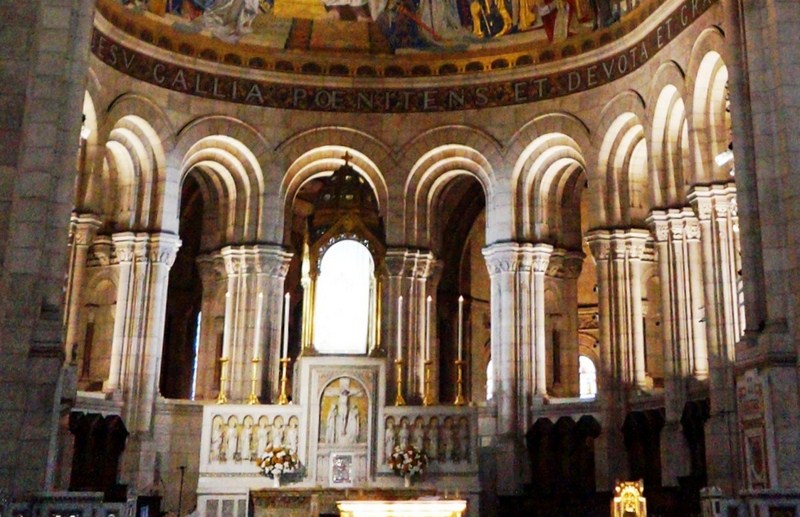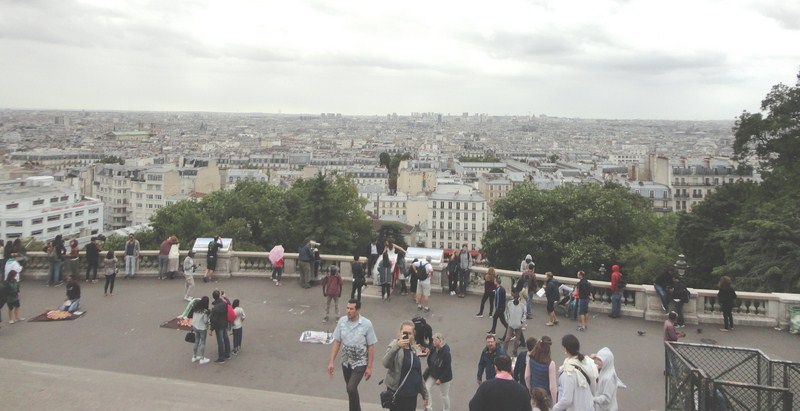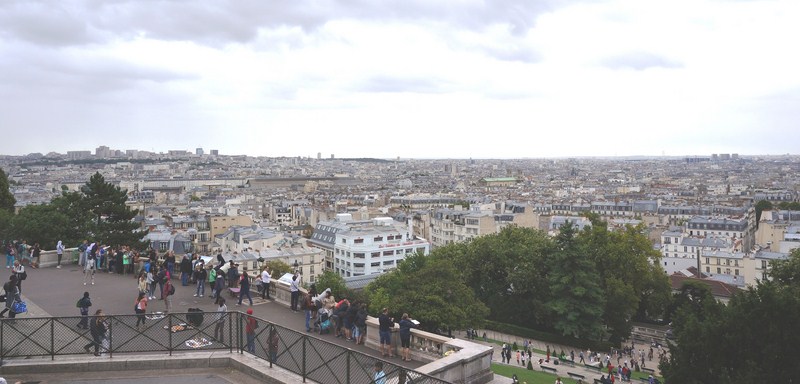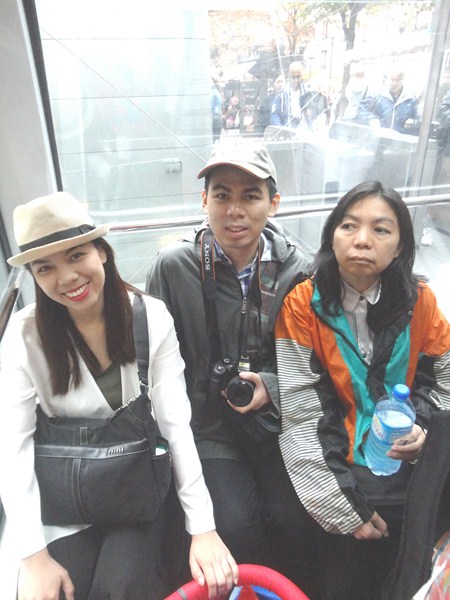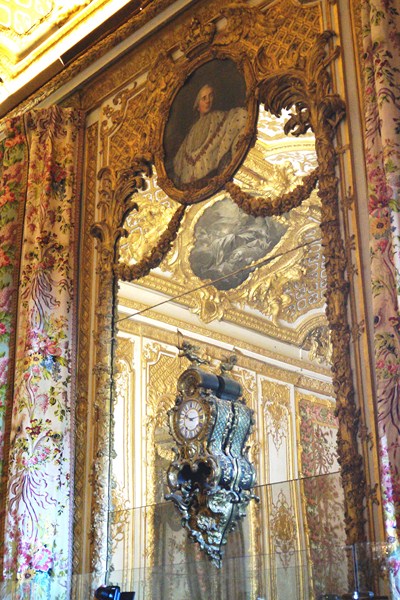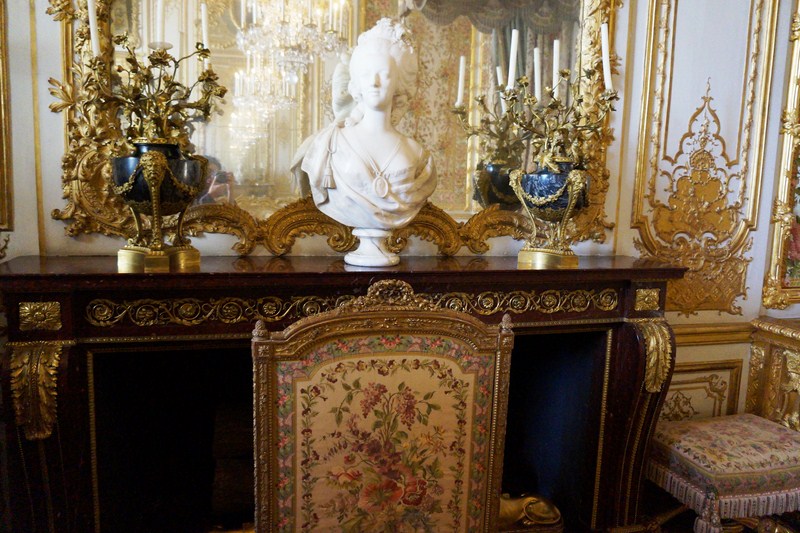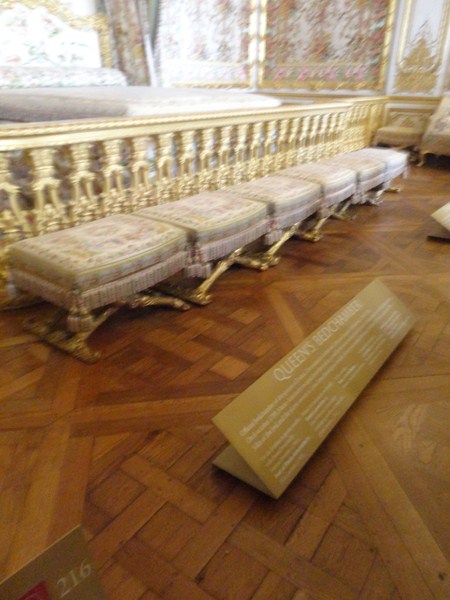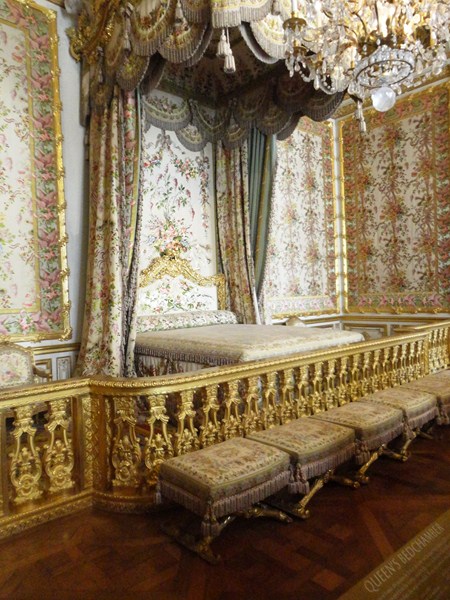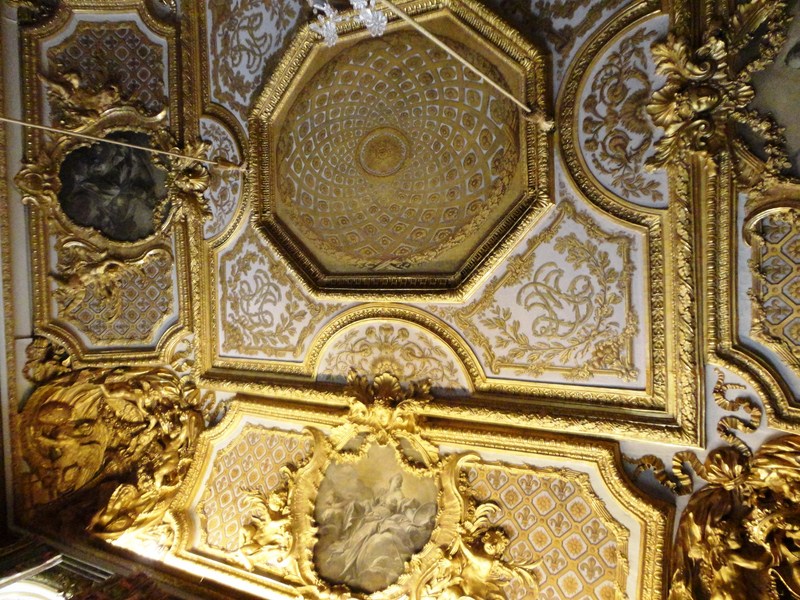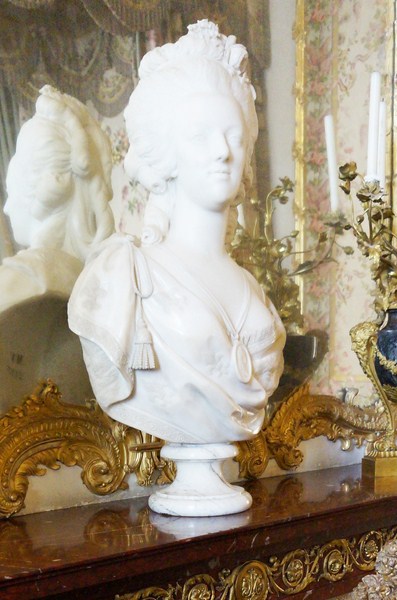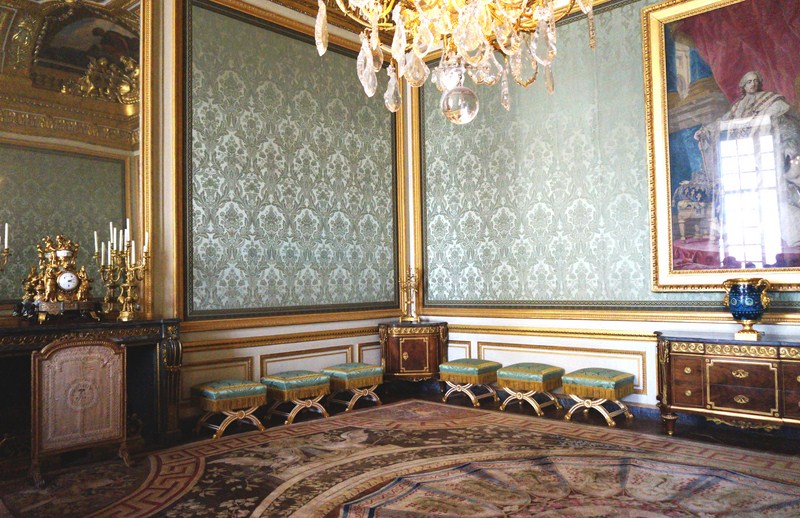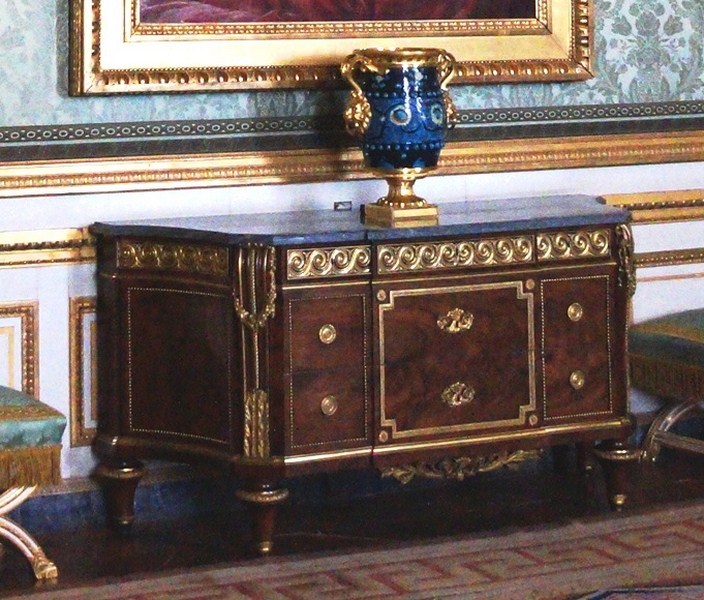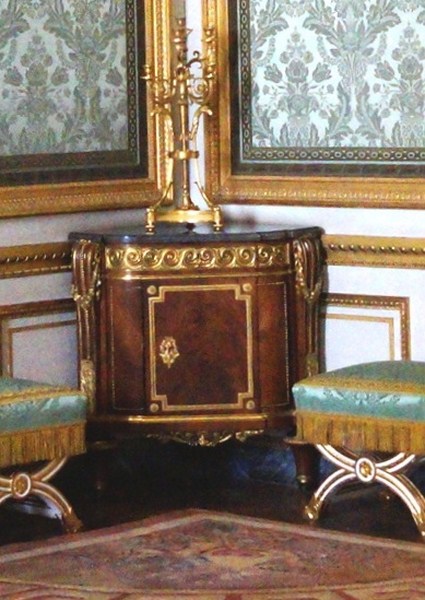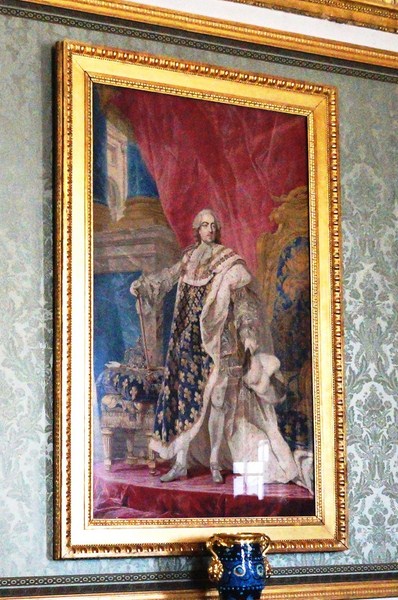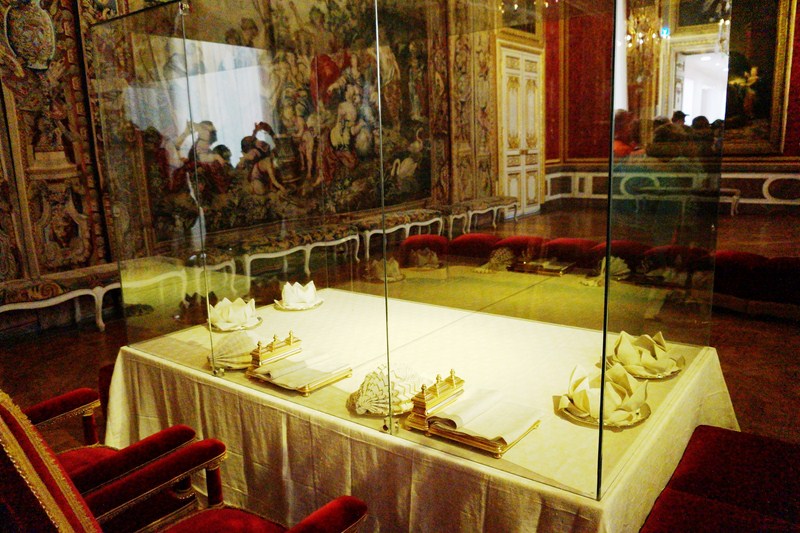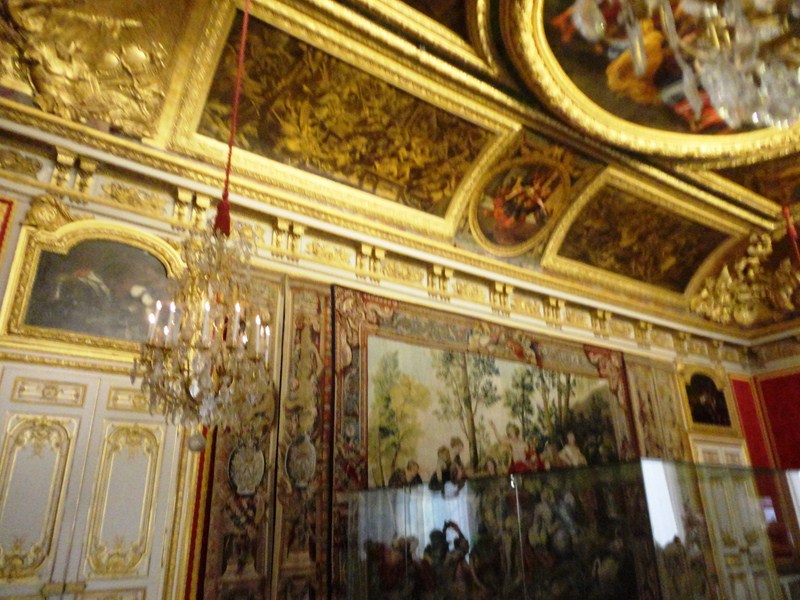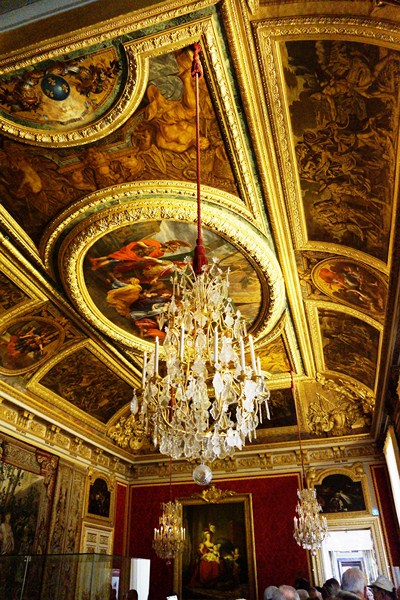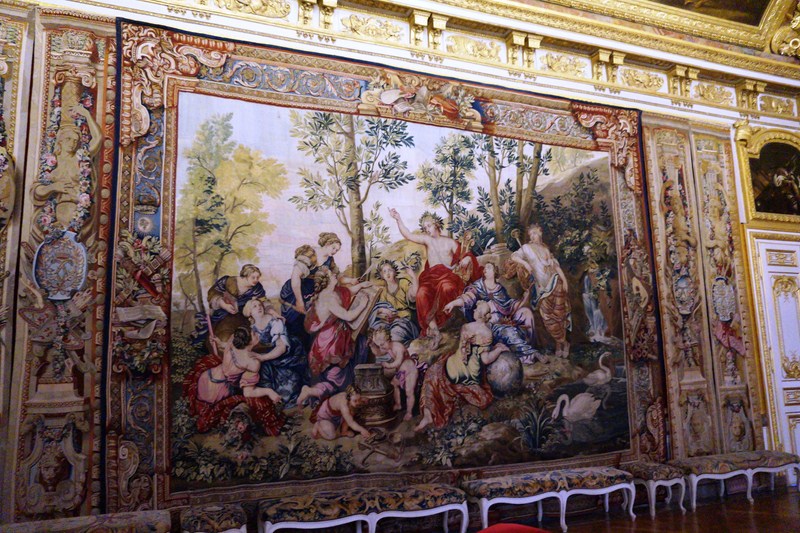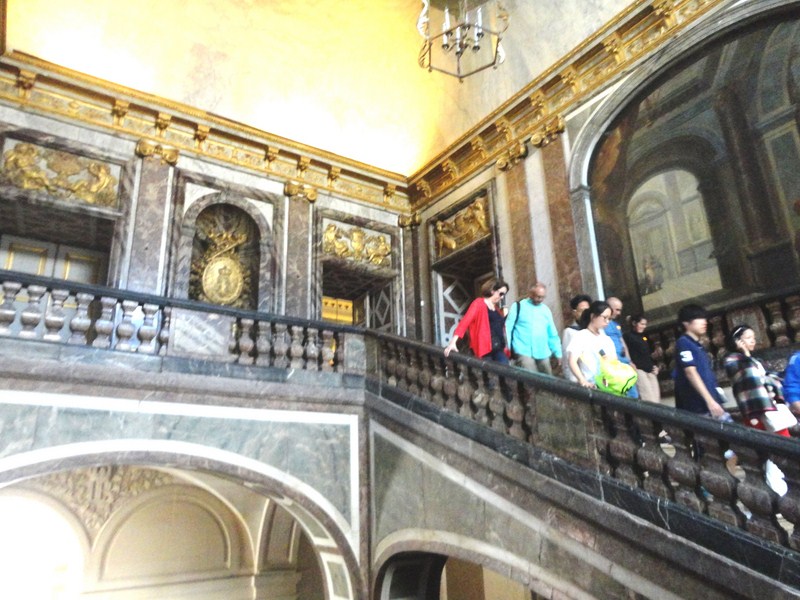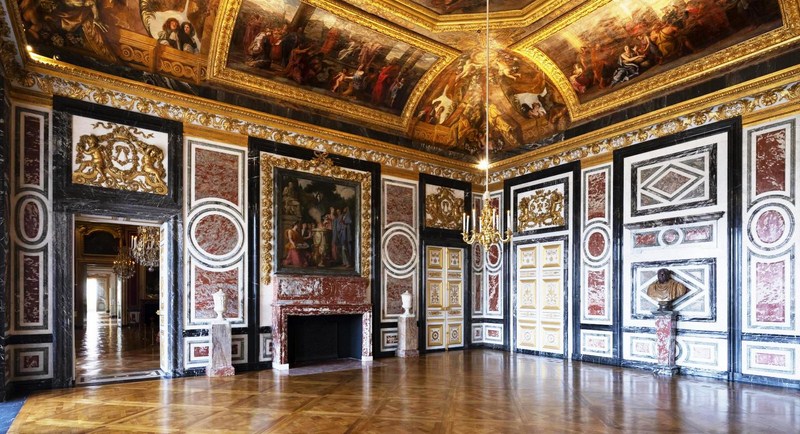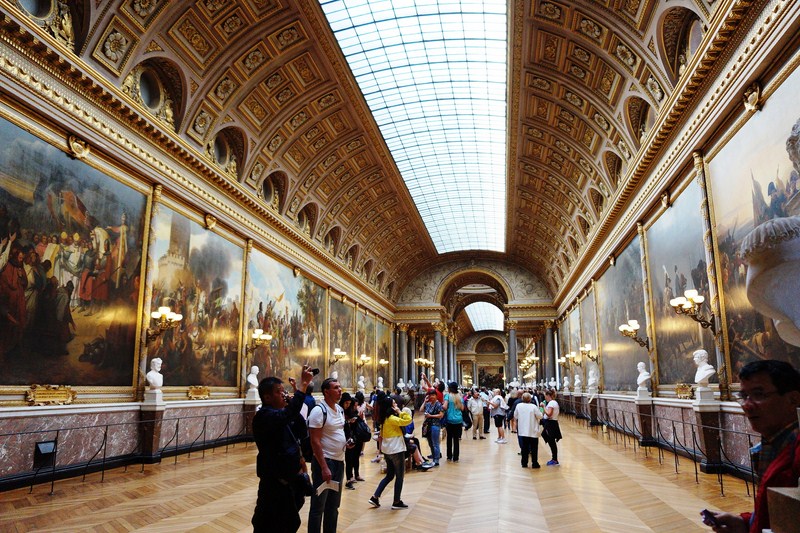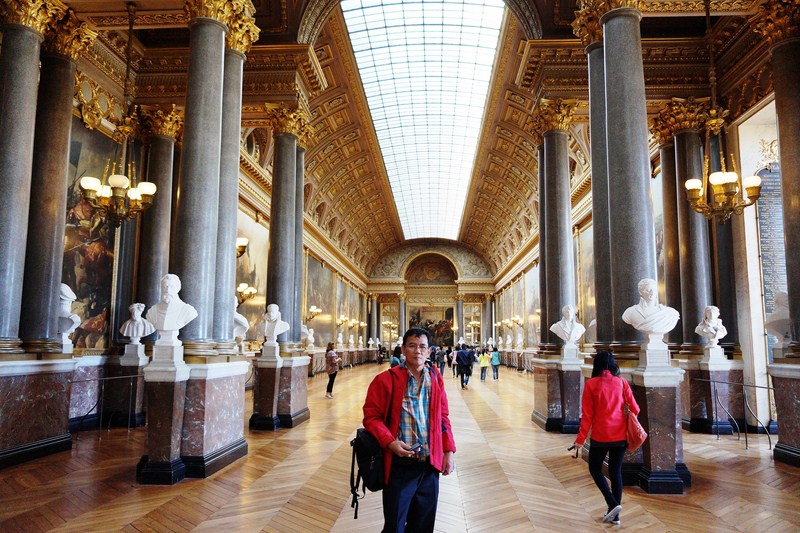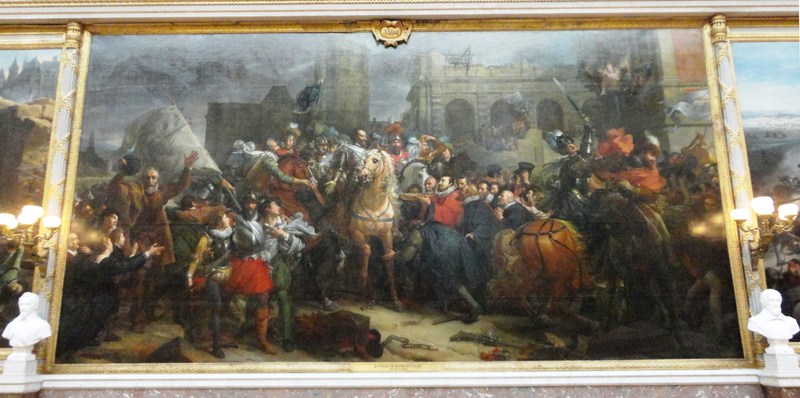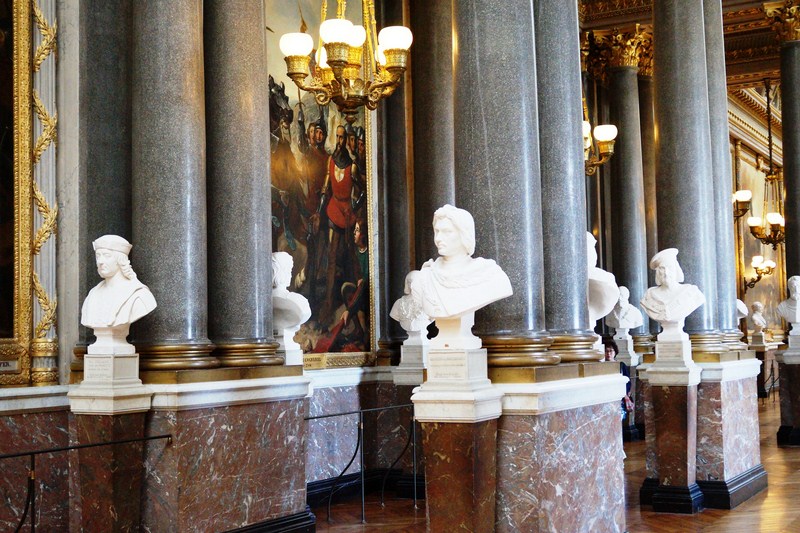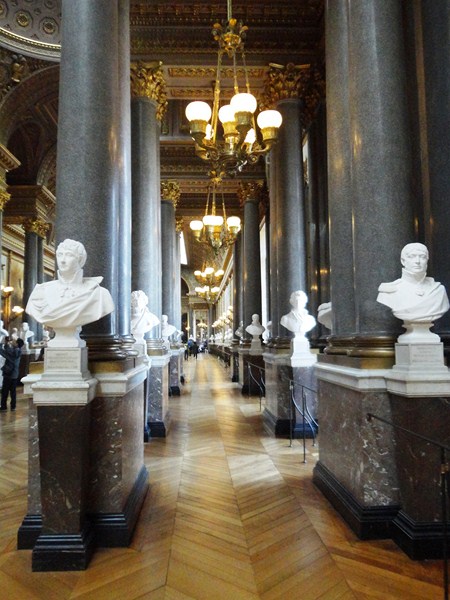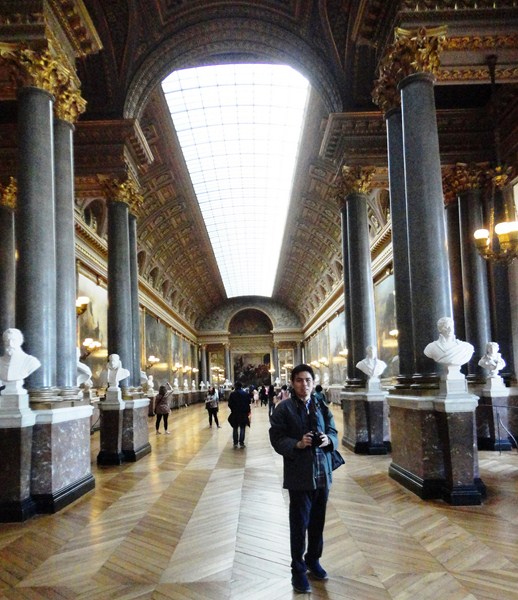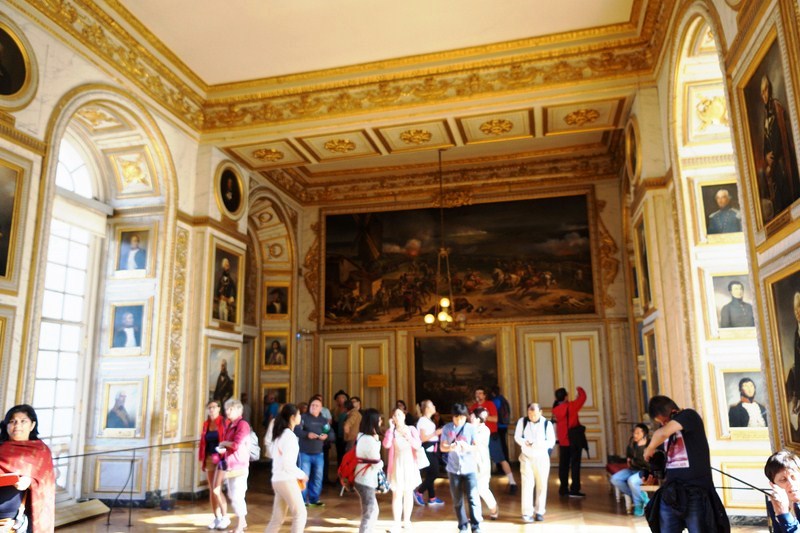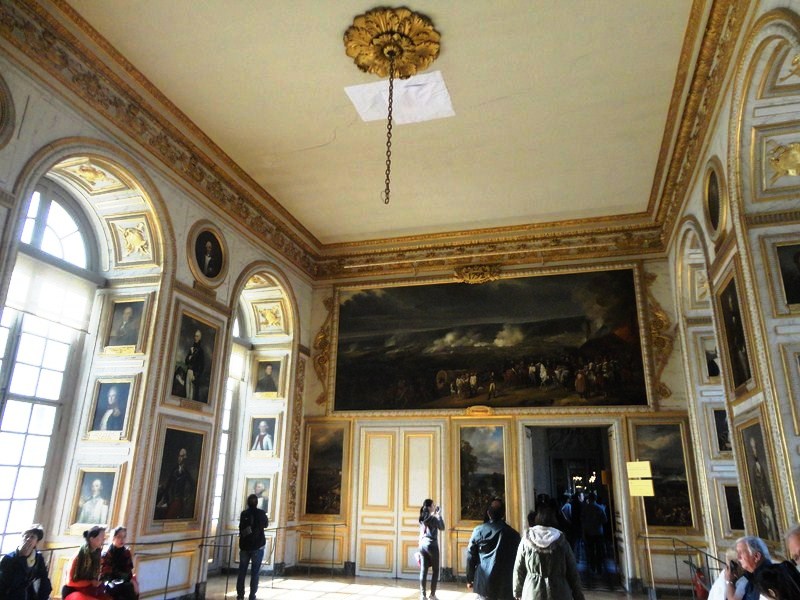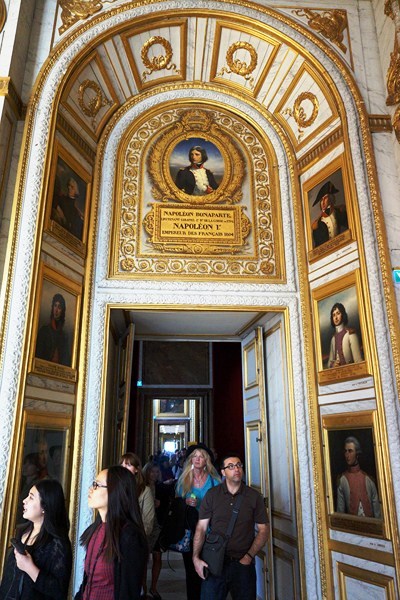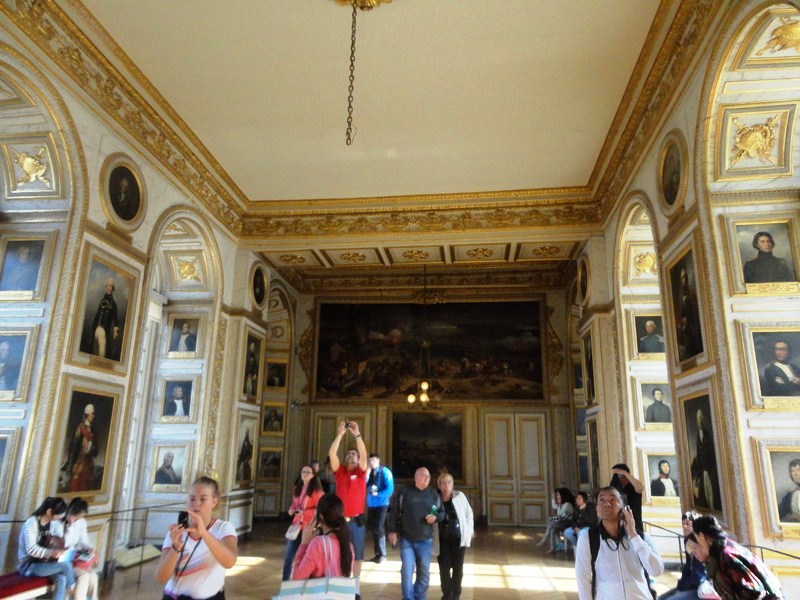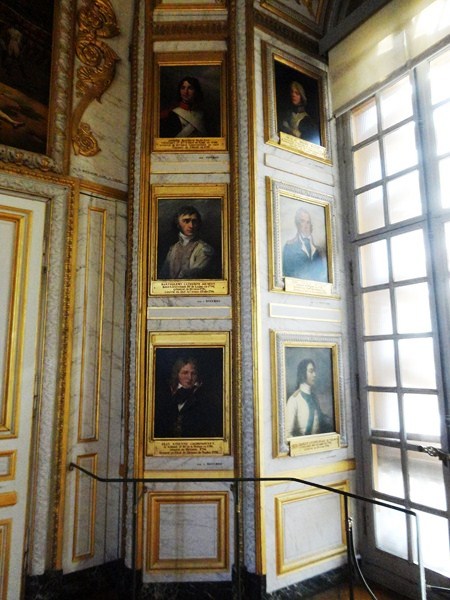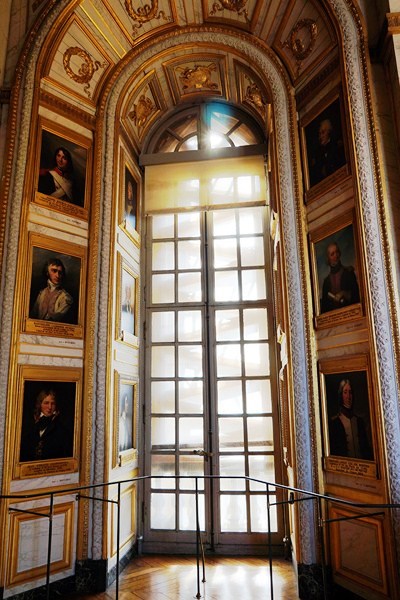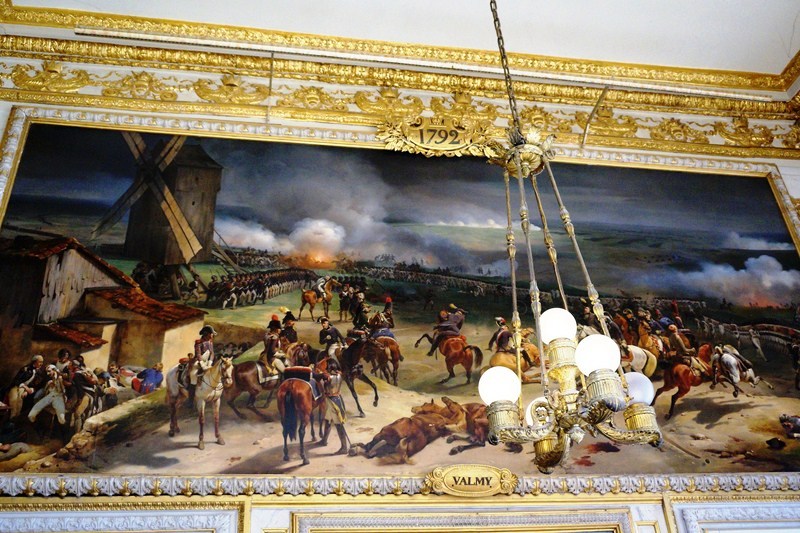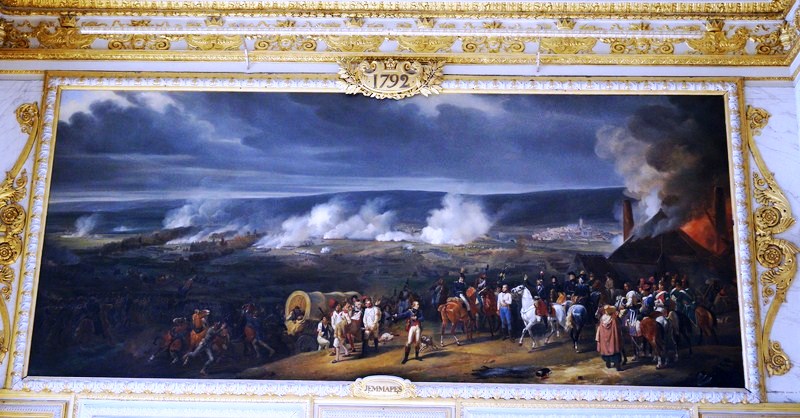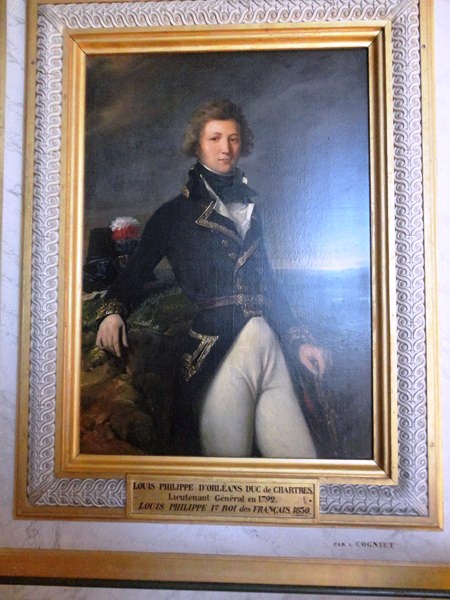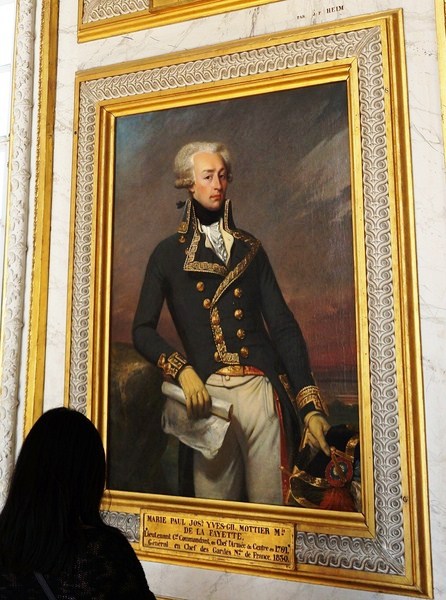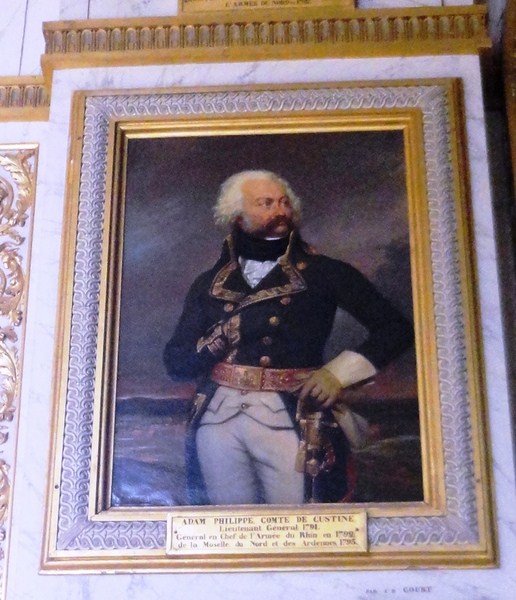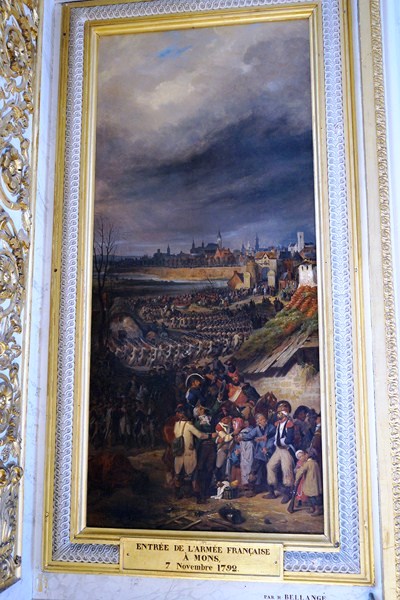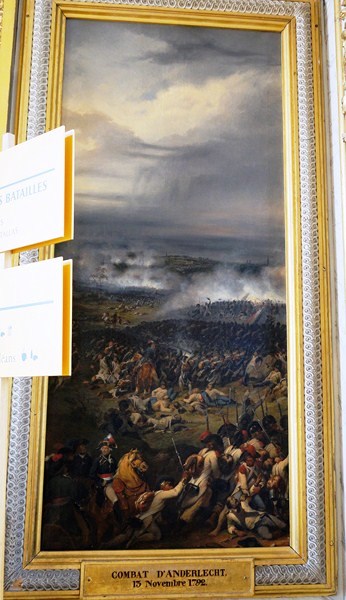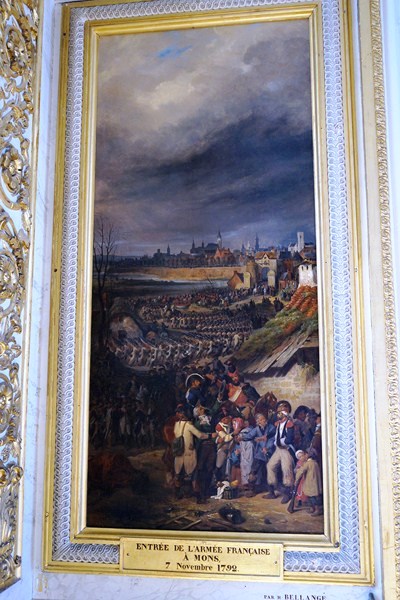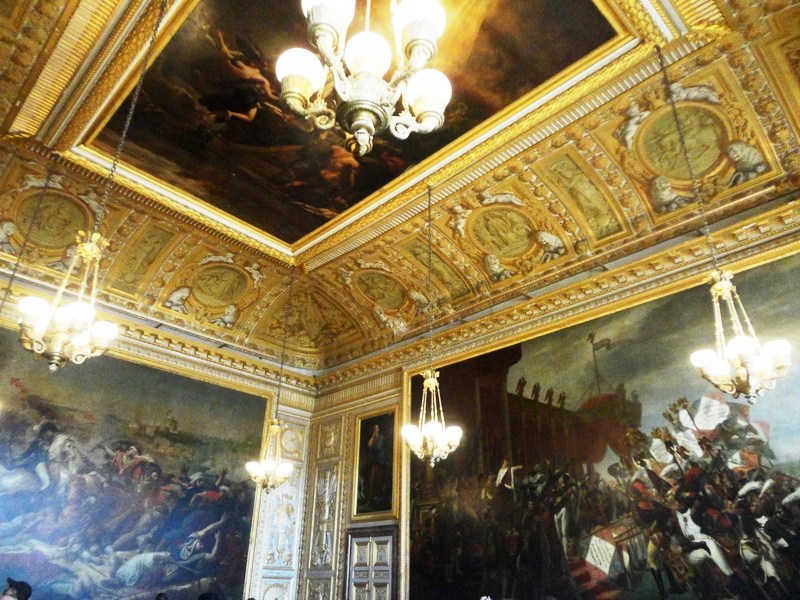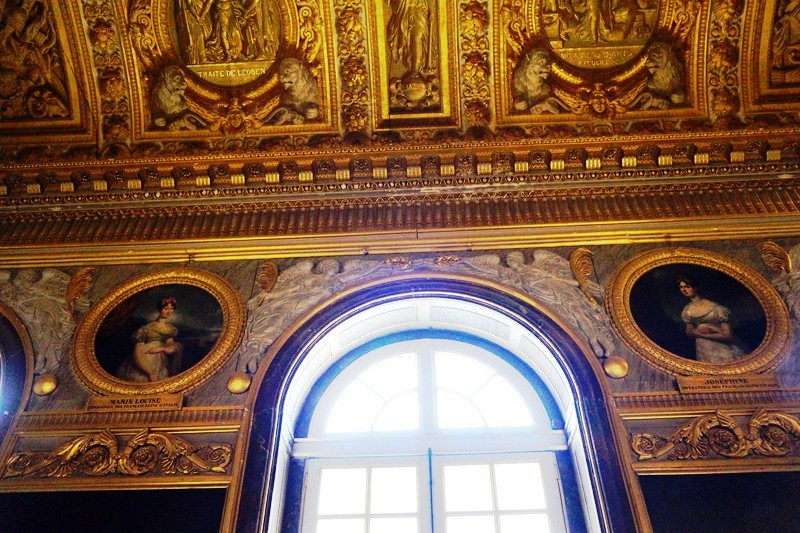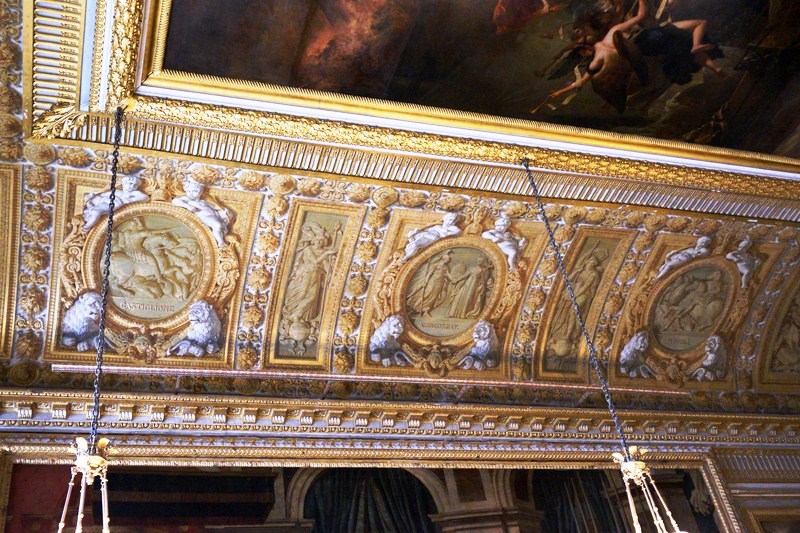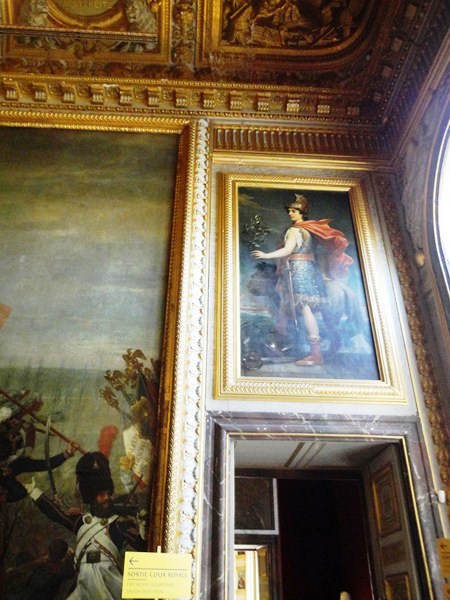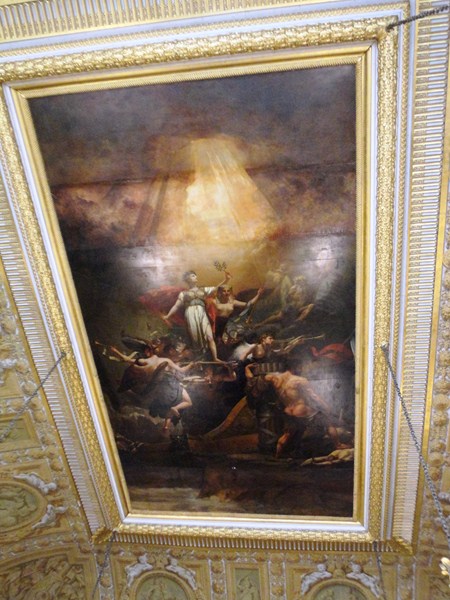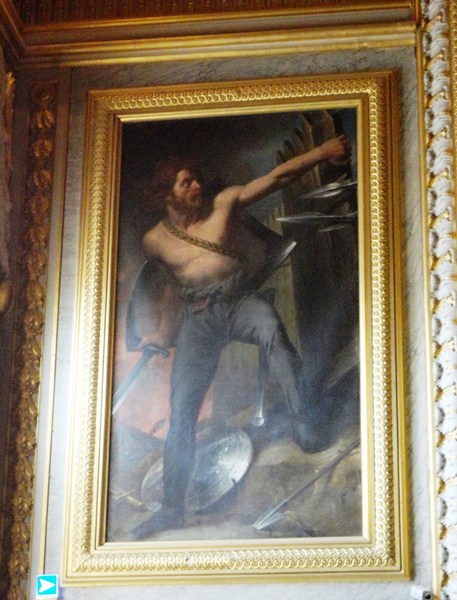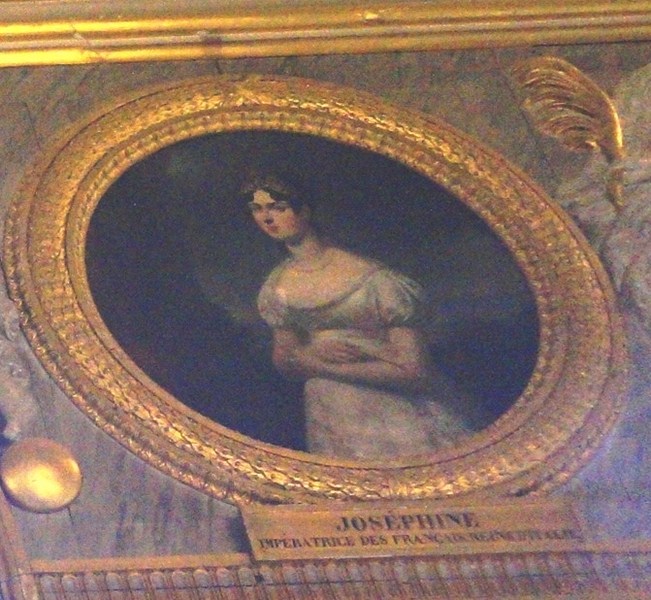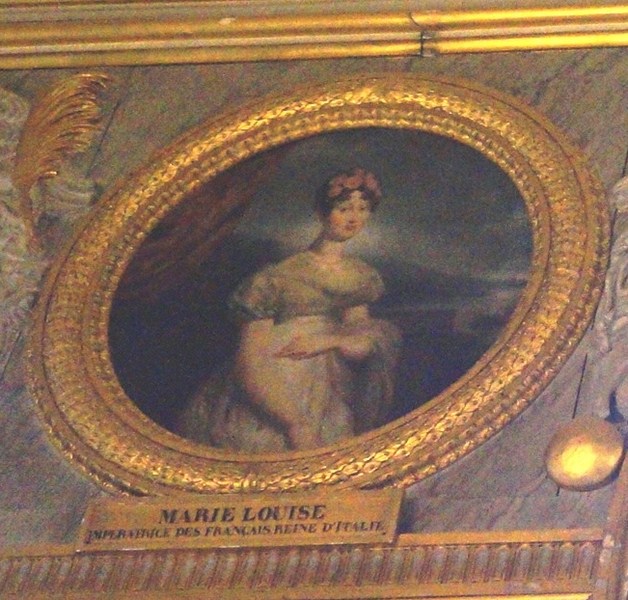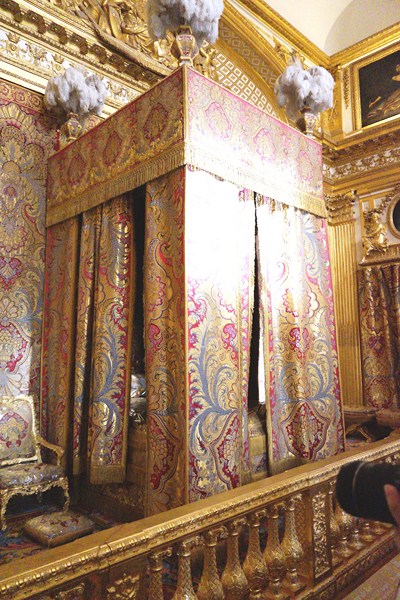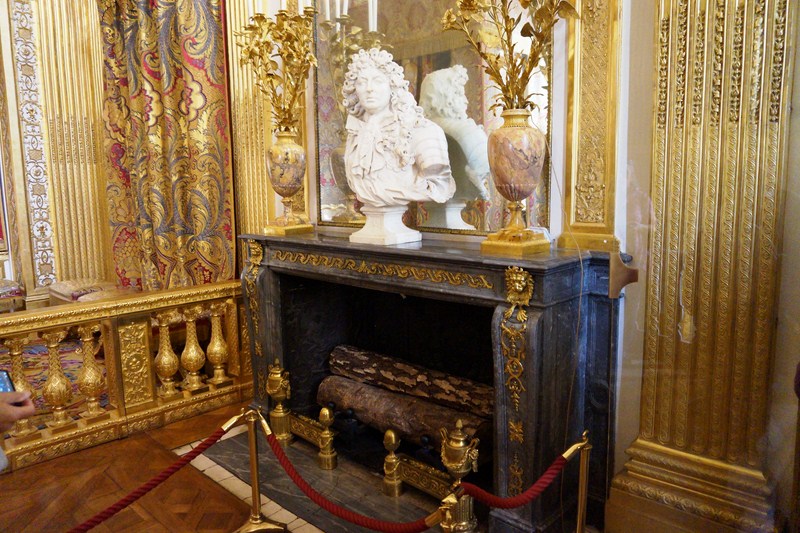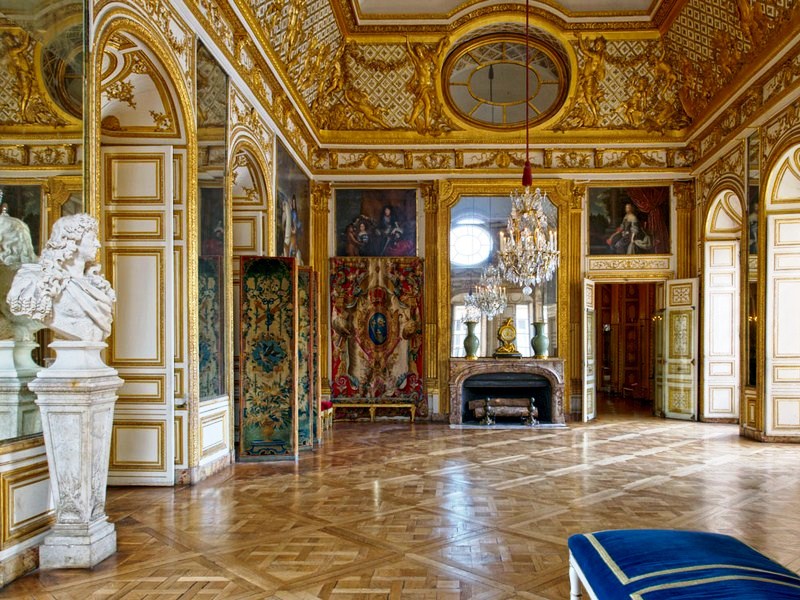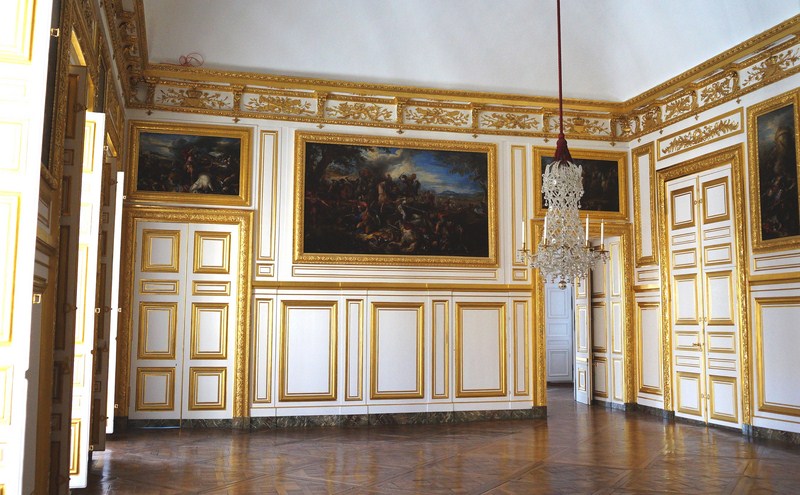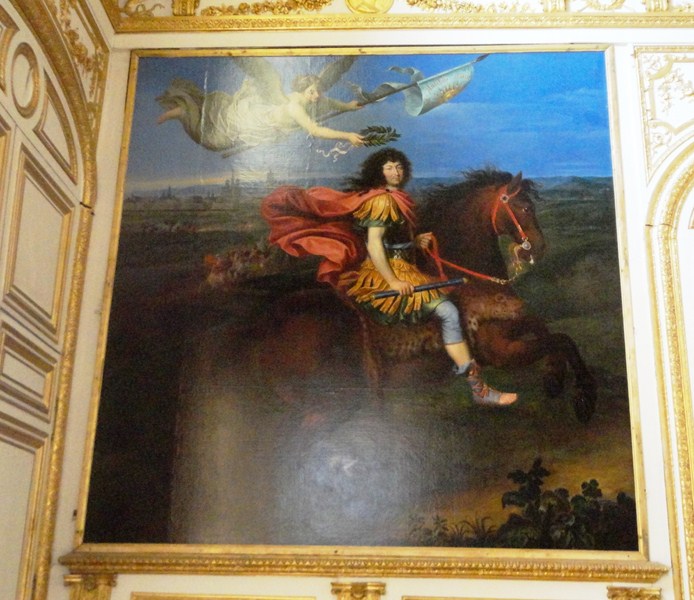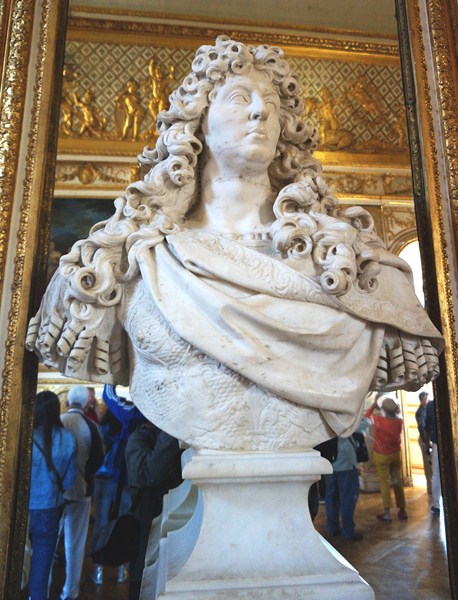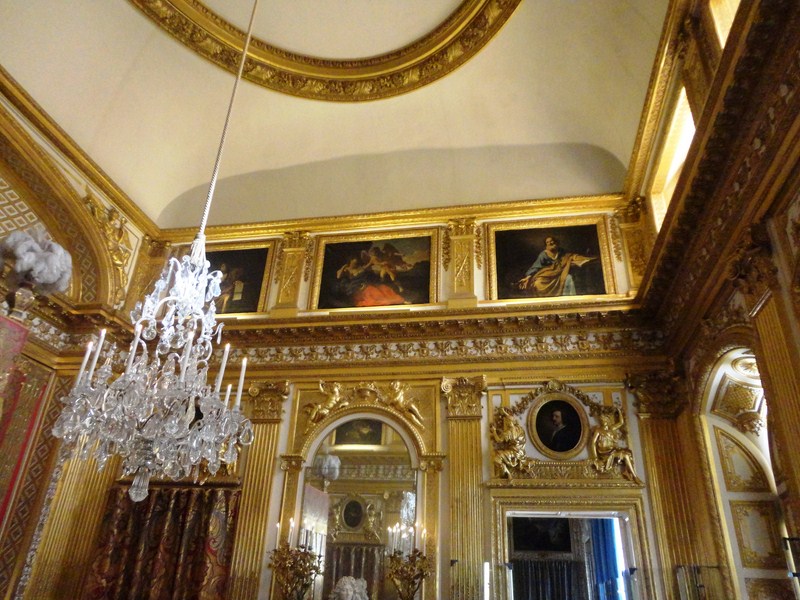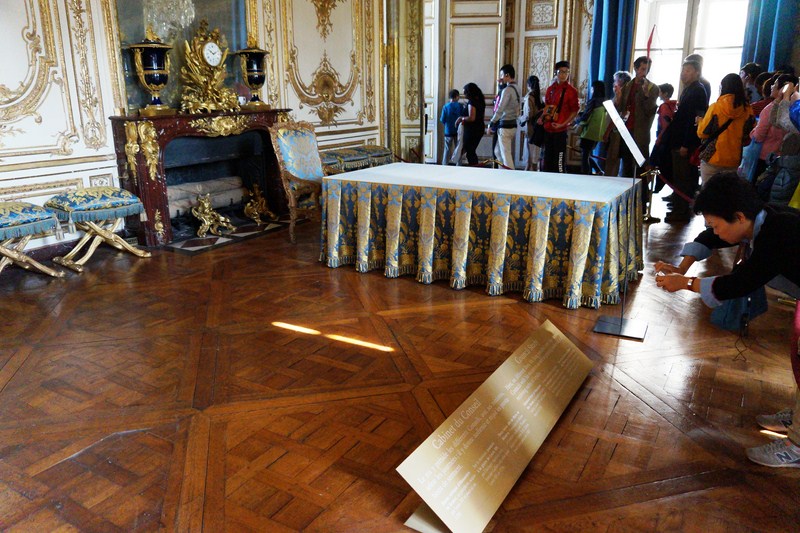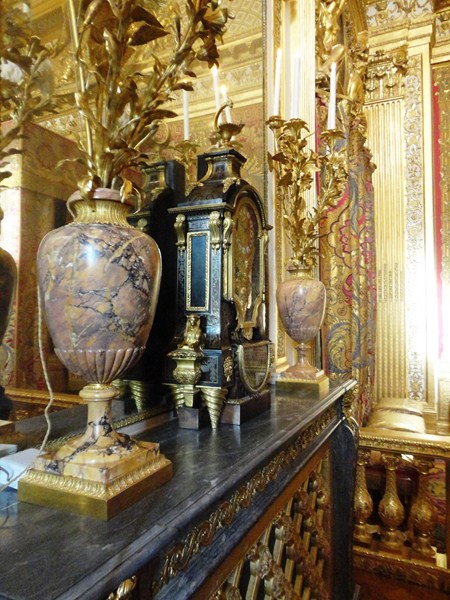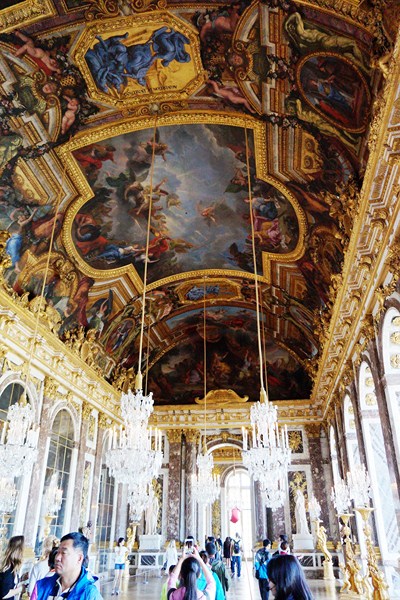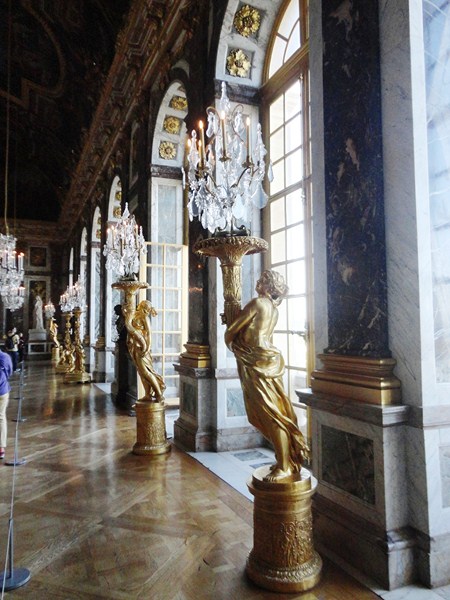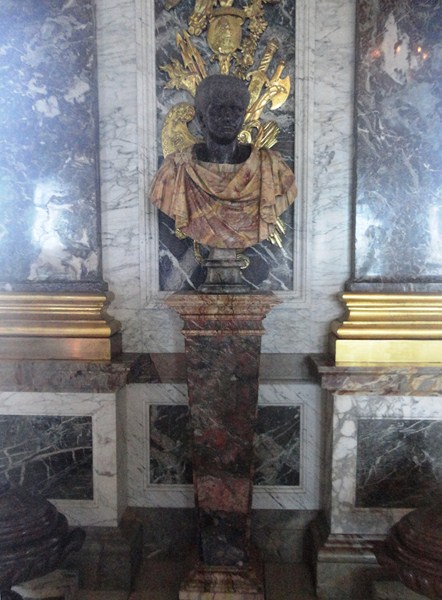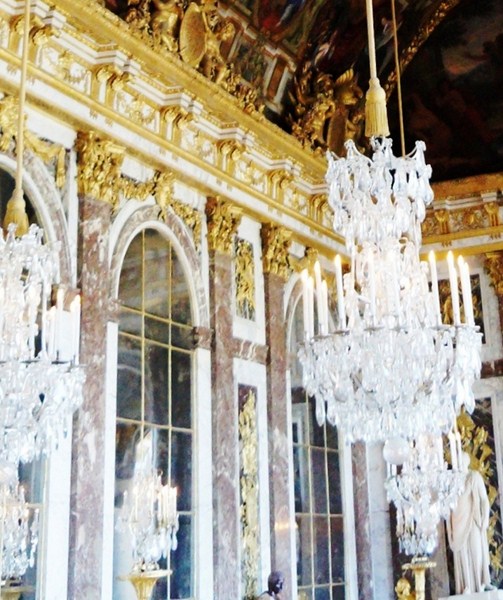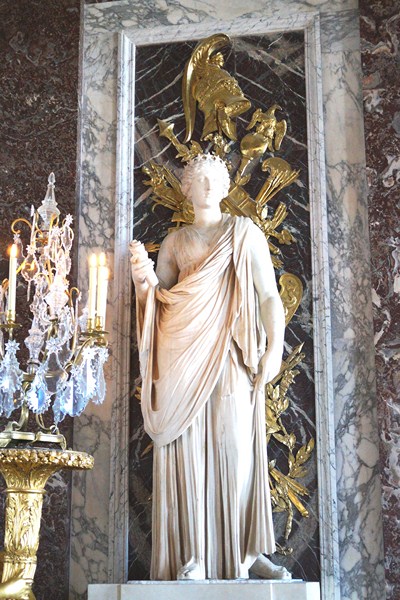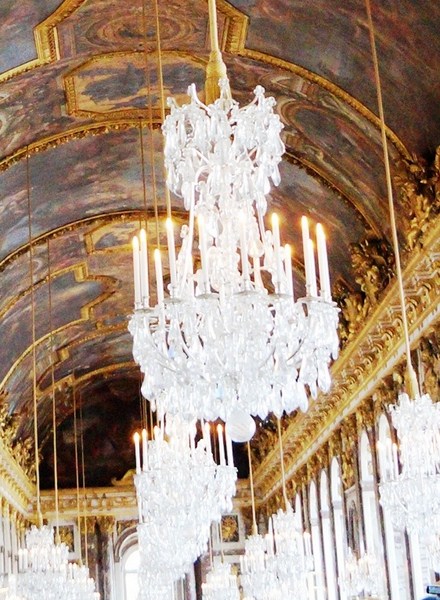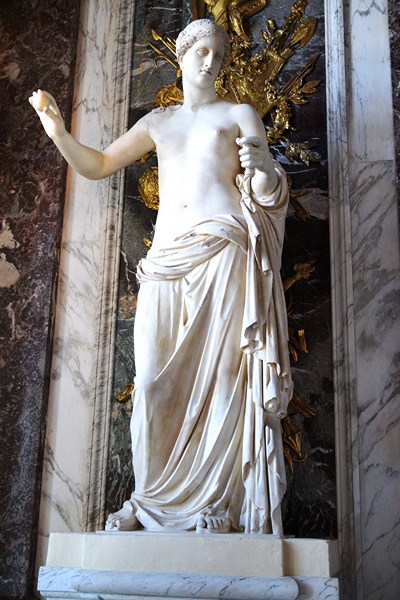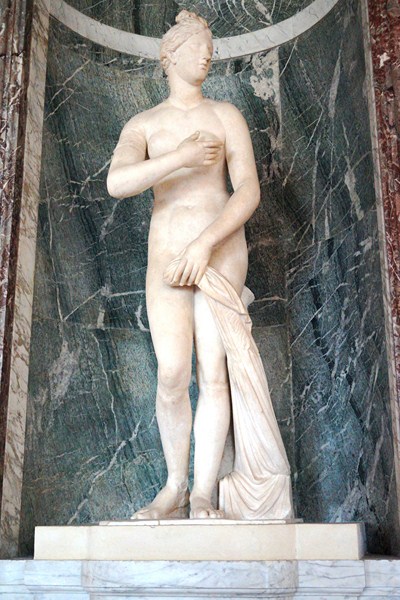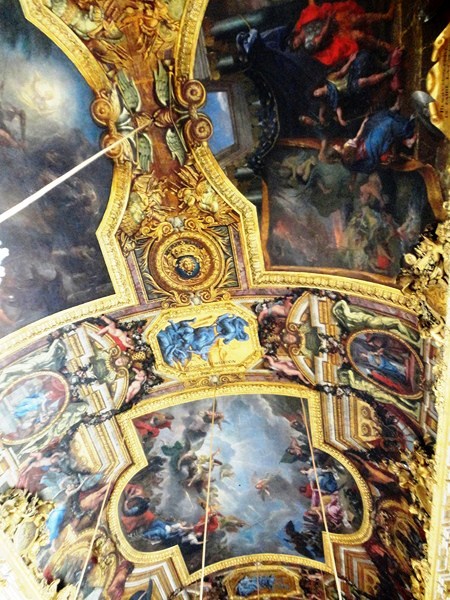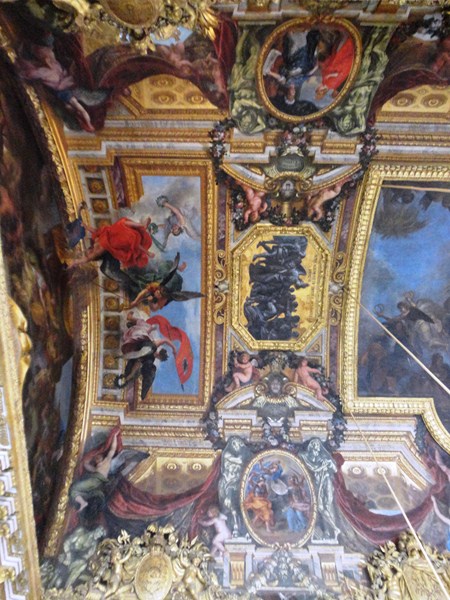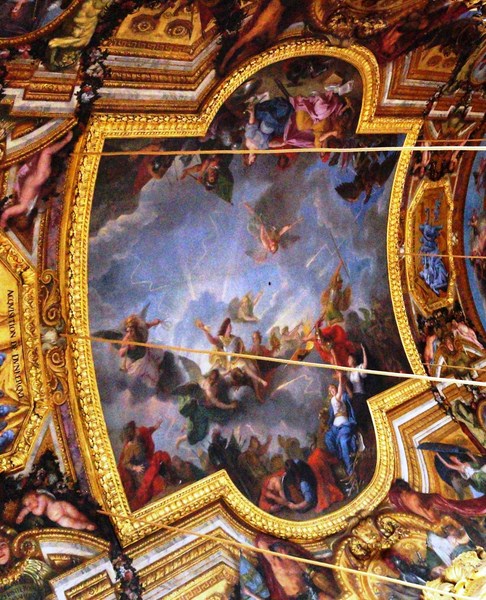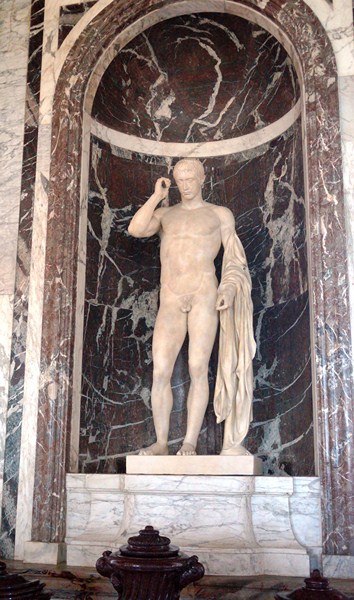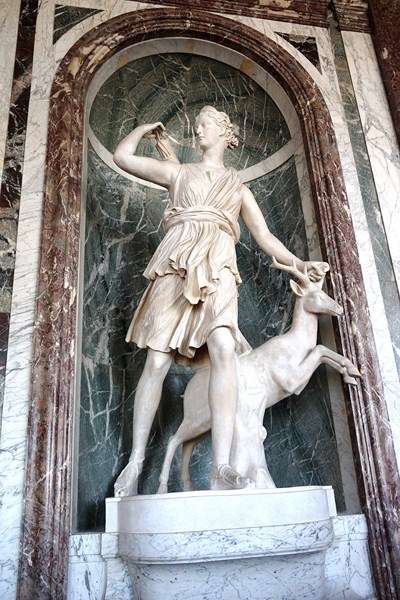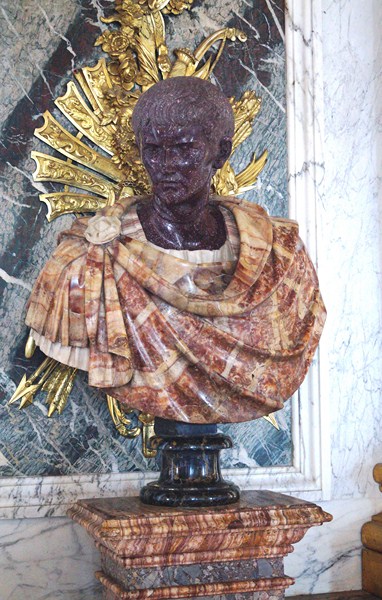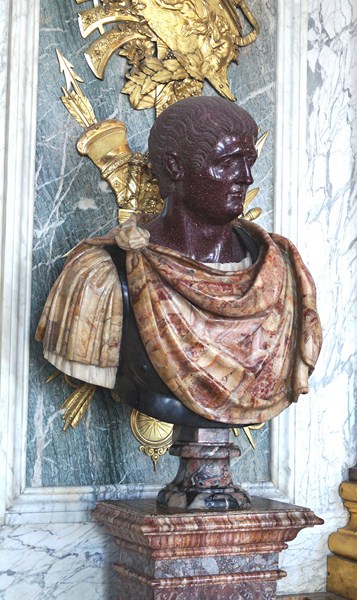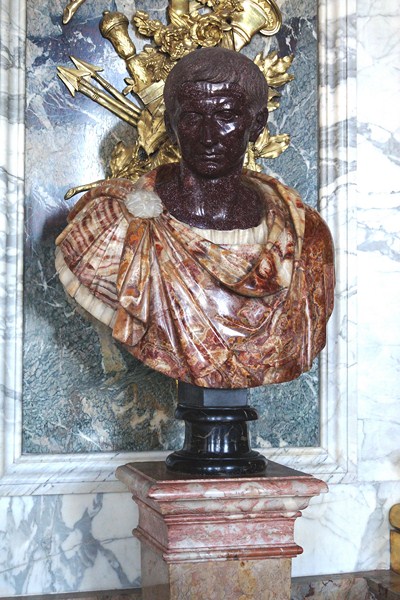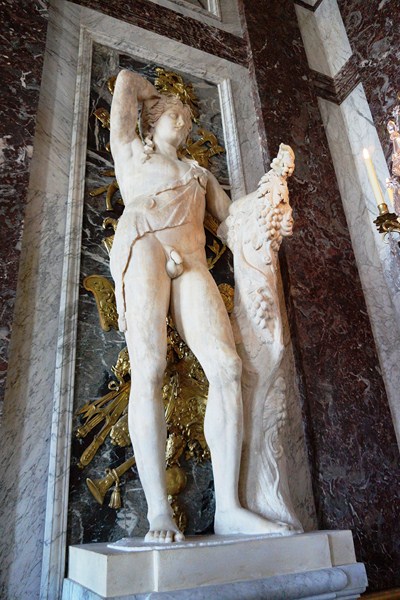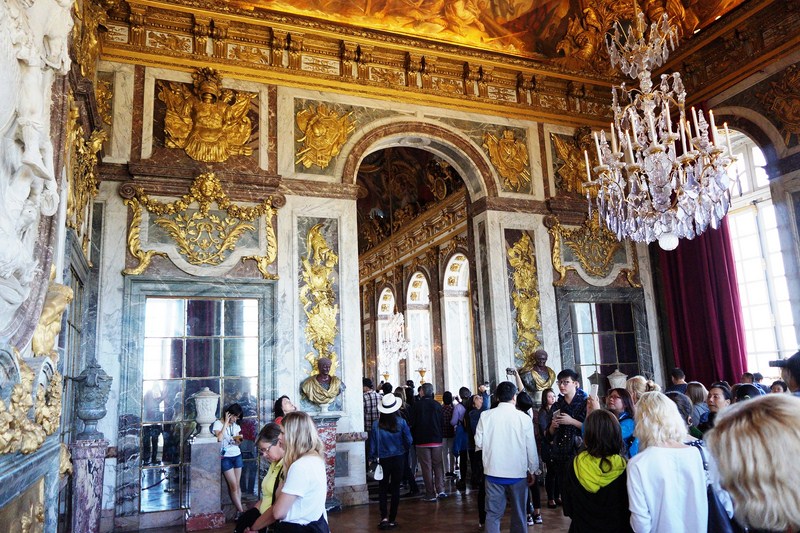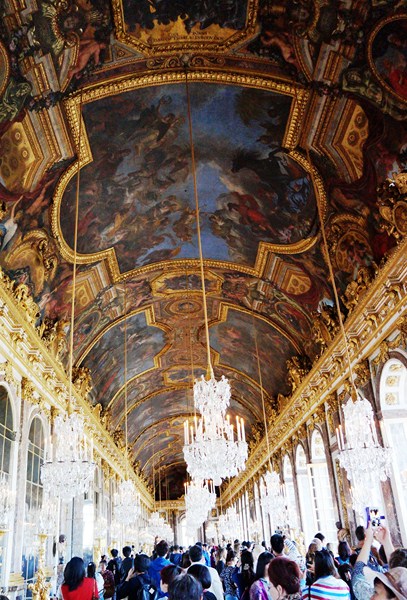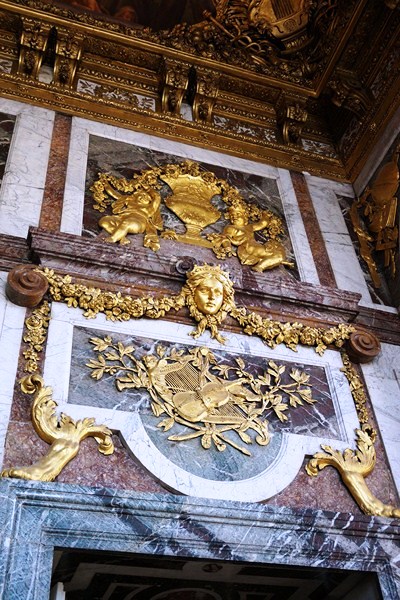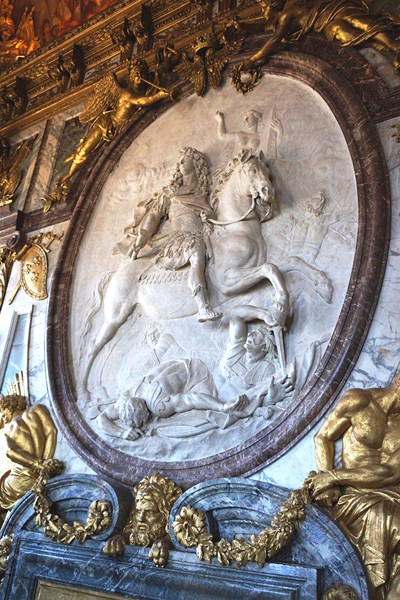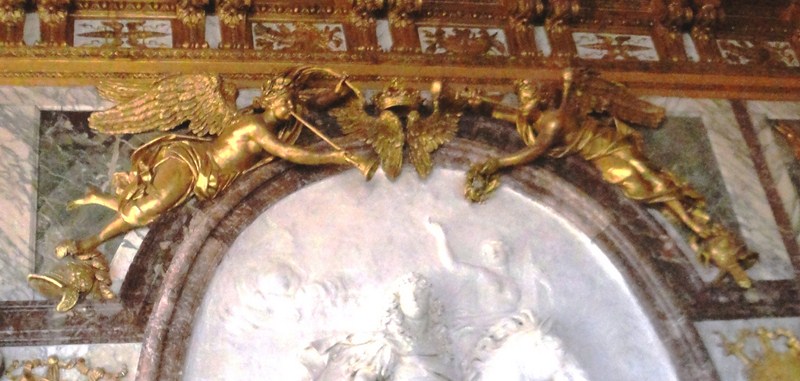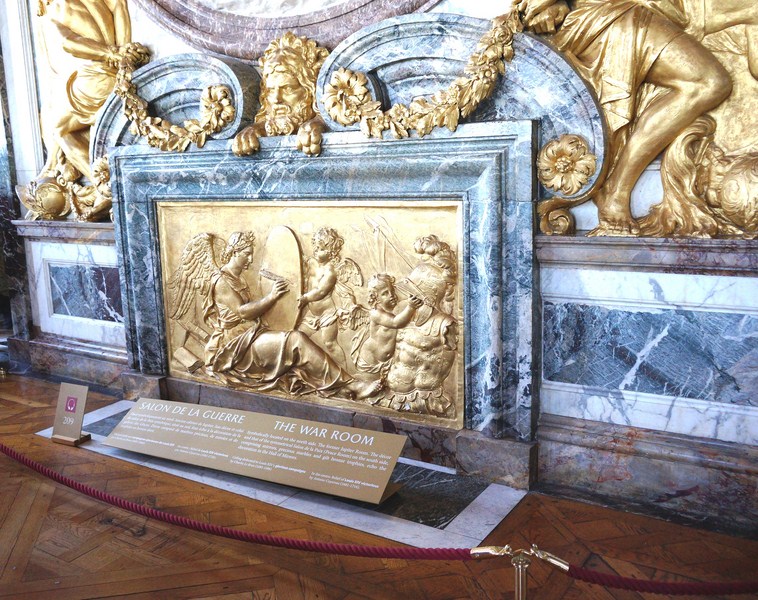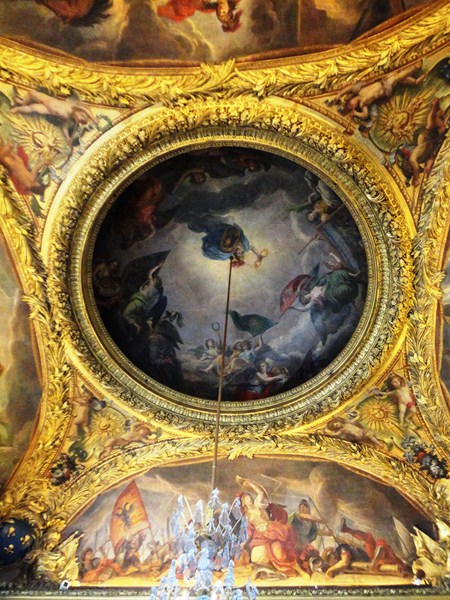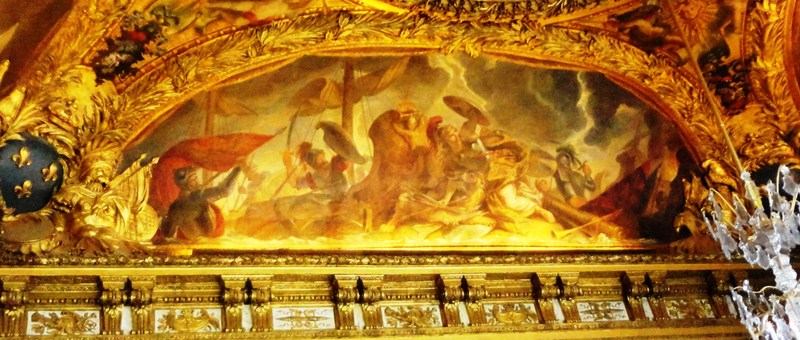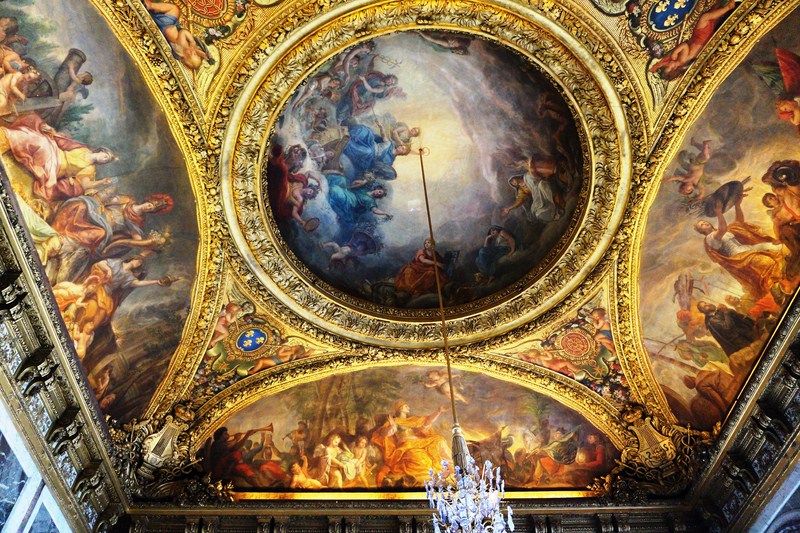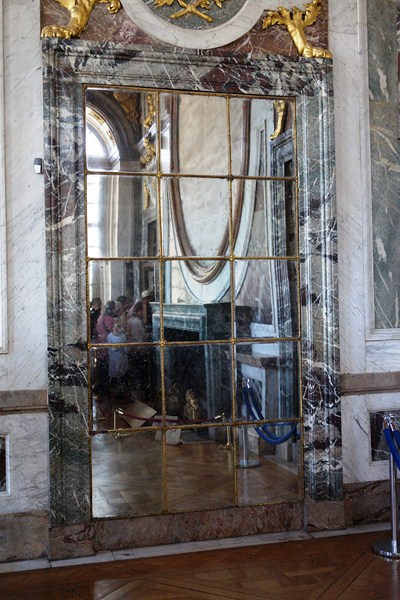Category Archives: France, Republic of
Gare de Paris Est Train Station (Paris, France)
It was our last day in Paris and, after breakfast at the hotel, we all walked, with our luggage in tow, to the nearby Gare de Paris Est Train Station, one of six large SNCF (Société nationale des chemins de fer français or “National society of French railways” or “French National Railway Company”) termini in Paris. Here, we were to take the train to Munich (Germany), the first leg of our trip to Salzburg (Austria).
One of the largest and the oldest railway stations in Paris, it is the western terminus of the Paris–Strasbourg railway and the Paris–Mulhouse railway. It provides train transportation to major cities in Central Europe such as Zurich, Switzerland; Munich, Germany and Vienna, Austria.
Opened in 1849 by the Compagnie du Chemin de Fer de Paris à Strasbourg (the Paris-Strasbourg Railway Company) under the name “Strasbourg platform” (corresponds today with the hall for main-line trains), it was designed by architect François Duquesnay and was renamed the “Gare de l’Est” in 1854, after the expansion of service to Mulhouse.
The Paris East Train Station (Gare de Paris-Est) represents the Belle Epoque generation of railway buildings. The west wing is the original building built in 1847 and, in 1854, due to increased rail traffic, the east wing was built.
In 1885 and 1900, the Gare de l’Est station was renovated and, in 1931 it was doubled in size, with the new part of the station built symmetrically with the old part, thus significantly changing the surrounding neighborhood.
At the top of the west façade is a statue by the sculptor Philippe Joseph Henri Lemaire, representing the city of Strasbourg, while the east end of the station is crowned by a statue personifying Verdun, by Varenne. Strasbourg and Verdun are important destinations serviced by Gare de l’Est.
On October 4, 1883, the Gare de l’Est Station saw the first departure, for Istanbul, of the Orient Express . As a terminus of a strategic railway network extending towards the eastern part of France, the Gare de l’Est saw large mobilizations, at the beginning of World War I, of French troops, most notably in 1914. In the main-line train hall, a monumental painting by Albert Herter, dating from 1926, illustrates the departure of these soldiers for the Western front.
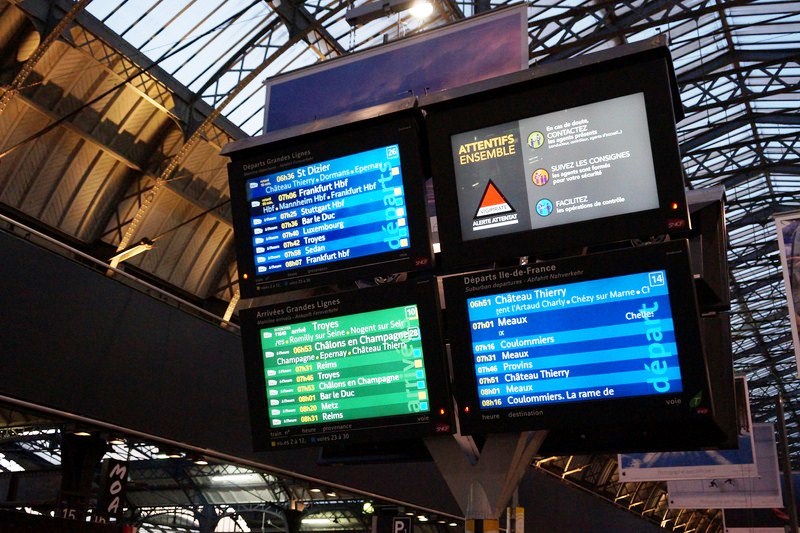 Paris Est Train Station: Place du 11 Novembre 1918, Rue du 8 Mai 1945, 75010 Paris, France. Open daily, 5:30 AM – 1 AM.
Paris Est Train Station: Place du 11 Novembre 1918, Rue du 8 Mai 1945, 75010 Paris, France. Open daily, 5:30 AM – 1 AM.
Basilica of the Sacred Heart of Paris (Paris, France)
From the Eiffel Tower, we again walked to the Champ de Mars Metro Station where we took the Metro to Anvers, the nearest Metro station to our next destination – the imposing Basilica of the Sacred Heart of Paris, known for its many artists that have been omnipresent since 1880. From Anvers, we walked for 2 to 3 mins., up the Rue Steinkerque, to the hill at the foot of Sacre-Couer.
Upon arrival, we all rode the Montmartre Funicular (a.k.a. Funiculaire de Montmartr) which runs from Place Suzanne-Valadon to Place Willette below Sacre-Couer. Other tourists climbed the staircase alongside the tracks. It was cold, windy and overcast during our visit.
This minor basilica, in the 18th arrondissement, to the west of the Gare de Nord and north of the Opéra Garnier, is commonly known as Sacré-Cœur Basilica or simply Sacré-Cœur (French: Basilique du Sacré-Cœur). This popular and iconic landmark, located at the summit of the Butte Montmartre (said to be derived from either Mount of Martyrs or from Mount of Mars), the highest point in the city, is a double (political and cultural) monument.
Sacré-Cœur is both a national penance for the secular uprising of the Socialist Paris Commune of 1871 (Montmartre had been the site of the Commune’s first insurrection) and the subsequent defeat of France in the 1871 Franco-Prussian War and is publicly dedicated to the Sacred Heart of Jesus, an increasingly popular vision of a loving and sympathetic Christ.
Designed by Architect Paul Abadie (who won over 77 other architects in a competition), its foundation stone was laid on June 16, 1875. Abadie died in 1884 and 5 architects continued with the work: Honoré Daumet (1884–1886), Jean-Charles Laisné (1886–1891), Henri-Pierre-Marie Rauline (1891–1904), Lucien Magne (1904–1916, who added an 83 m./272-ft. high clock tower), and Jean-Louis Hulot (1916–1924)
It was not completed until 1914, when war intervened, and was formally consecrated on October 16, 1919, after the end of World War I when its national symbolism had shifted. The structure’s overall style, showing a free interpretation of Roman–Byzantine features, is a conscious reaction against the Neo-Baroque excesses of the Palais Garnier, which was cited in the competition, and has many design elements that symbolize nationalist themes.
Built with travertine quarried in Château-Landon (Seine-et-Marne), its stone, when it rains, reacts to the water and exudes calcite which acts like a bleacher, ensuring that the basilica remains white even with weathering and pollution. Its portico, with three arches, is adorned by two bronze equestrian statues of French national saints Joan of Arc (1927) and King Saint Louis IX, both done (by Hippolyte Lefebvre. The 19 ton Savoyarde bell, one of the world’s heaviest, was cast in 1895 in Annecy. It alludes to the annexation of Savoy in 1860. The Savoyarde clock, at the clock tower, is one of the world’s largest.
A 480 sq. m. mosaic in the apse ceiling, entitled Christ in Majesty and created by Luc-Olivier Merson, is the largest in France and among the largest in the world. On display in a monstrance above the high altar is the Blessed Sacrament (a consecrated host which, according to Church teaching, has become by the consecration of the priest Christ’s Body and Blood during Mass), continually on display there since 1885.
The basilica also has a large and very fine pipe organ, built by Aristide Cavaillé-Coll and installed in Paris in 1905 by Charles Mutin Cavaillé-Coll’s successor and son-in-law), is composed of 109 ranks and 78 speaking stops spread across four 61-note manuals and the 32-note pedalboard (unusual before the start of the 20th century; the standard of the day was 56 and 30), spread across three expressive divisions (also unusual for the time, even in large organs). The organ was ahead of its time, containing multiple expressive divisions and giving the performer considerable advantages over other even larger instruments of the day.
The basilica complex includes a garden for meditation, with a fountain. From its parvis, we had one of those perfect Paris postcard views. The top of the dome (the second-highest point in Paris after the Eiffel Tower), open to tourists, affords a spectacular panoramic 360°view (up to 30 kms. on a clear day) of the city of Paris, which is mostly to the south of the basilica.
The entrance to the dome and the chapel-lined crypt is located on the left side of the basilica. Buy a ticket, then climb a steep 234-step spiral staircase to the base of the dome. The crypt can also be visited for an additional €2.
Sacre Couer de Montmartre Basilica: 35 Rue du Chevalier de la Barre, 75018 Paris, France. Tel: +33 1 53 41 89 00. Website: www.sacre-coeur-montmartre.com. Open day, 6 AM to 10:30 PM. Admission is free. The dome is accessible from 9 AM to 7 PM in the summer and 6 PM in the winter. When visiting the basilica, tourists and others are asked to dress appropriately and to observe silence as much as possible, so as not to disturb persons who have come from around the world to pray in this place of pilgrimage. The use of cameras and video recorders is forbidden inside the Basilica.
How to Get There: The basilica is accessible by buses 30, 31, 80, and 85 which can be taken to the bottom of the hill of the Basilica. Line 12 of the Metro can be taken to Jules Joffrin station and visitors can then change to the Montmartrobus and disembark at Place du Tertre. Line 2 or 12 of the Metro can be taken to Pigalle station where visitors can change to the Montmartrobus and disembark at Norvins, or to Anvers station which gives easy access to the steps or the funicular car that leads directly to the Basilica. The Montmartrobus operates on a circular route from Place Pigalle (near the Pigalle Métro stop) to the top of the Butte, where you can get off for the short walk to Sacré-Coeur. Or you can stay on the bus until it goes down and around the other side of the hill, then passes Sacré-Coeur on its way back to Pigalle.
Versailles Palace – Queen’s Grand Apartment (France)
The Queen’s Grand Apartment (grand appartement de la reine), a suite of rooms, of exceptional splendor, in the Palace of Versailles that were reserved for the personal use of the queen, overlooks the Parterre du Midi and formed a parallel enfilade with that of the Grand Apartment of the King (grand appartement du roi,).
Check out “Versailles Palace“
The queen’s apartments served as the residence of three queens of France, originally arranged for the use of Marie-Thérèse d’Autriche (wife of Louis XIV, she died not long after moving in, in 1683), by Marie Leczinska (wife of Louis XV) and, finally, for the Austrian archduchess Marie-Antoinette (wife of Louis XVI). Additionally, Princess Marie-Adélaïde of Savoy (Duchesse de Bourgogne), Louis XIV’s granddaughter-in-law and wife of the Petit Dauphin, occupied these rooms from 1697 (the year of her marriage) to her death in 1712.
When Louis Le Vau‘s envelope of the old palace (château vieux) was completed, the Queen’s Grand Apartment came to include a suite of seven enfilade rooms on the first floor in the left wing with a perfectly symmetrical layout that mirrored, almost exactly, the Grand Apartment of the King in the right wing.
The Chapel corresponded to the Salon de Diane in the King’s Grand Apartment, the Salle de Gardes to the Salon of Mars (Salon de Mars), the Antichambre to the Salon of Mercury (Salon de Mercure), the Chambre to the Salon of Apollo (Salon d’Apollon), the Grand Cabinet to the Salon of Jupiter (Salon de Jupiter), the Oratory to the Salon of Saturn (Salon de Saturne) and the Petit Cabinet to the Salon of Venus (Salon de Vénus).
Check out “Versailles Palace – State Apartments of the King”
With regards to the ceiling decoration, those in the Grand Apartment of the King depicted the heroic actions of Louis XIV as allegories from events taken from the antique past while the decoration of the Queen’s Grand Apartment depicted heroines from the antique past and harmonized with the general theme of a particular room’s decor.
The construction of the Hall of Mirrors, which began in 1678, changed the configuration of the Queen’s Grand Apartment. The chapel was transformed into the Queen’s Guards Room (salle des gardes de la reine) and the decorations from the salon de Jupiter were reused here. The Queen’s Guards Room communicates with a loggia that issues from the Queen’s Staircase (escalier de la reine), which corresponded (albeit a smaller, though similarly-decorated example) to the Ambassador’s Staircase (escalier des ambassadeurs ) in the King’s Grand Apartment.
Check out ““Versailles Palace – Hall of Mirrors”
The loggia also provides access to the King’s Grand Apartment. Toward the end of Louis XIV‘s reign, the Queen’s Staircase became the principal entrance to the palace, with the Ambassador’s Staircase used on rare state occasions. In 1752, after the destruction of the Ambassador’s Staircase, the Queen’s Staircase became the main entrance to the palace.
However, this was soon changed when the king decided to set aside all the rooms around the Marble Courtyard for his new apartments, limiting the queen’s space to her State Apartments (which were modified by Marie Leczinska and later Marie-Antoinette) and to a few smaller rooms for more private use, situated behind the official apartments, overlooking two inner courtyards. The Queen’s Apartments consist of the Queen’s Bedchamber (Chambre de la reine), the Nobles’ Room, the Antechamber to the Grand Couvert (formerly the Salle des gardes) and the Queen’s Guard Room (Salle des gardes de la reine).
In 1729, to commemorate the birth of his only son and heir, Louis, Louis XV ordered a complete redecoration of the room. Elements of the Queen’s Bedchamber (chambre de la reine), as it had been used by Marie-Thérèse d’Autriche and Princess Marie-Adélaïde of Savoy, were removed and a new, more modern decor was installed.
During her life at Queen’s Grand Apartment, Marie Leszczynska (1703–1768) annexed the salon de la paid to serve as a music room. In 1770, when Marie-Antoinette married the dauphin (later Louis XVI), she took up residence in these rooms and, upon Louis XVI‘s ascension to the throne in 1774, ordered major redecoration of the Queen’s Grand Apartment which achieved the arrangement that we see today.
The Bedchamber, the most important room in the apartments, is where the Queen spent most of her time, where she slept (often with the king) and, in the morning, where she received guests during and after her toilette (like the King’s getting-up ceremony, it was a courtly affair controlled by strict etiquette).
It was also here that the queen gave birth, in public (actually misleading since, in reality, only doctors, ladies in waiting, the governess of the Princes and Princesses of the Realm, the Princesses of the royal family and a few members of the church were allowed to enter) to the Princes and Princesses of the Realm. The queen was placed on a labor bed specially brought in, and was hidden behind a screen or canvas tent.
After giving birth, she was returned to her own bed while the whole court (waiting in the other rooms in the Apartment whose doors were all symbolically left open) filed through to present their compliments. Between 1682 and 1786, 19 Princes and Princesses of the Realm were born here and two queens died here (Maria-Theresa in 1683 and Marie Leszczyńska in 1768).
The decoration in the room, still reflecting the three queens who once occupied it, features partitions on the ceiling dating back to the reign of queen Marie-Thérèse d’Autriche, a greyscale painting by François Boucher and wood panelling added for Marie Leszczyńska, all elements that survived the reign of Marie-Antoinette who replaced the furniture and fireplace and put up paintings of her mother Empress Maria-Theresa and her brother, Emperor Joseph II.
The jewelry cabinet, commissioned to Schwerdfeger by Marie-Antoinette, is placed in its original position in the alcove to the left of the bed. The 1745 Baillou and Crescent clock Marie-Antoinette placed in the bedchamber has been restored to its place. Other items returned to the room include Sené’s chimney piece, andirons by Boizot and Thomire and the bedspread by Desfarges.
Other pieces of furniture which were sold at an auction that lasted a year, such as the sofa delivered for the Countess of Provence (the queen’s sister-in-law), have been replaced by similar items. The armchairs by Tilliard and folding stools were taken from the suite of rooms belonging to the Countess d’Artois. The fabrics, hanging on the bed and walls, were re-woven in Lyon using the original patterns; the bed and balustrade have been remade and the Savonnerie carpet rewoven using ancient documents.
The Grand Cabinet, now the Nobles’ Room (salon des nobles), was used as a second antechamber where Queen Marie Leszczyńska (and, later, Marie-Antoinette) held formal audiences, seated under a canopy, as well as her Circle (the name given to the times spent in orderly conversation by the ladies of the Court). When not used for formal audiences, the Noble’s Room served as an antechamber to the queen’s bedroom.
In 1785, Marie-Antoinette, not too fond of the Louis XIV style of the room, entrusted Richard Mique, her architect, with completely redecorating it (except for the ceiling which was kept). Apple-green damask, bordered with a wide gold stripe, were hung on the walls, and new, extremely modern and refined furniture were delivered.
When making the majestic commodes and corner cupboards for the room, the queen’s favorite cabinetmaker Riesener followed the latest English fashion by abandoning the customary marquetry in favor of large panels of mahogany. In this magnificent collection, the gilded bronze decoration and the small tables in Bleu Turquin marble matched the decoration on the new fireplace.
The ceiling paintings, by Michel Corneille, depicts Mercury Spreading his Influence over the Arts.
A tapestry portrait of Louis XV by Cozette hangs on the wall, with mythological paintings by Francois Boucher. The mantlepiece ornaments show a Turkish influence while the commodes and corner cupboards, by Riesner and Gouthière, are dated 1786. The overdoors depict Pygmalion and Dibutade by Regnault while the bronze fireplace ornaments are by Gouthière.
Traditionally, public meals at the Royal Table or Grand Couvert (a lavish court ceremony attracting a large number of curious, decently dressed onlookers), taken by the king and members of the royal family, were held at the Royal Table Antechamber, now the Antechamber of the Grand Couvert (Antichambre du Grand Couvert). Privileged duchesses, princesses or those holding important positions sat in front them on stools while the other ladies and people whose rank granted them entry or who were admitted by the ushers stood around them. In the 1680s, the room was sometimes used as a theatre for the château.
Almost every evening, Louis XIV strictly adhered to this ceremonial performance (seated alone at a table in front of the fireplace, his spoon, fork, and knife were brought to him in a golden box and courtiers could watch as he dined) whereas Louis XV, more often, preferred private dinners. Louis XVI and Marie-Antoinette only ate at the Royal Table once a week, sitting with their backs to the fireplace. Louis XVI ate well but Marie Antoinette, who was bored, requested that music be played during meals, installing a platform for musicians to this end.
Designed for Queen Marie-Thérèse d’Autriche, the room’s lower panels were made of marble and two famous paintings of Marie Antoinette hang on the walls, including that which includes all her children. Portraits of Louis XVI’s aunts by Madame Labille-Guiard are part of the decor. Above the doors are works by Madeline de Boulogne dated 1675.
The original, very large painting of ancient heroines on the ceiling, illustrating royal virtues, by the artist Claude-François Vignon and Paillet, quickly deteriorated and, in 1814-1815, was replaced with a Veronese canvas Saint Mark Rewarding the Theological Virtues. Later, in 1861, it was substituted by the current, equally large marouflé canvas, Darius’ Family at Alexander’s Feet, a tapestry cartoon painted by Henri Testelin after a work by Le Brun. The gilt stuccos were sculpted by Pierre I Le Gros the Younger and Benoît Massou.
In 2007, due to the bulging of the camaieus on the arches, emergency measures were taken. Between April 2009 and July 2010, the Antechamber of the Grand Couvert was restored, thanks to sponsorship from Martell & Co. Thanks to a 1788 inventory of the furniture in this room (the pieces were well documented but are now lost), the furniture is now as they would have been when the royal family was forced to leave the palace, with Louis XV period seats and stools with Savonnerie manufactory upholstery and a large table placed in the center of the room as it would be when the King and Queen sat down for the Grand Couvert. In order to evoke the royal dinnerware which is close to that used by French royalty but which disappeared during the Revolution, the Louvre lent silverware produced for George III of England by Robert-Joseph Auguste.
Facing the large windows is the tapestry Autumn or The Triumph of Bacchus and Ariadne, was put on deposit here by the Mobilier National from the ensemble in the gallery of the Château de Saint Cloud after cartoons by Pierre Mignard. A deep crimson damask fabric, woven according to the description afforded by a document from the first half of the 18th century, was placed on the walls.
The Queen’s Guard Room, where 12 of the Queen’s Guards (composed of soldiers from the four elite companies of the King’s Guards) were on duty day and night, controlled entry to the Queen’s Apartments from the Queen’s Staircase (also called the “Marble Staircase”). In 1672, the room was used as a Chapel and, in 1676-1681, received its final decoration.
Since the Queen never spent time here and there was therefore no need to modernize it, the Queen’s Guard Room is the only room in the Apartments in which the 17th-century decoration has been fully preserved, still contains the marble paneling, enhanced with gilded bronze designed by Le Brun and executed by Le Gros and Massou, characteristic of the State Apartments’ original condition, as well as the paintings, by Noël Coypel, which were brought here in 1680 from the old Jupiter Drawing Room (later replaced by the War Room).
At dawn on October 6, 1789, a group of rioters demanding bread tried to enter the Queen’s Apartments. Warned by one of the queen’s guards, one of the ladies in waiting managed to bolt the door to the Antechamber of the Grand Couvert and help the queen hurry, through a private corridor, to the king’s apartments, via her private chambers, and flee from the Paris mob.
NOTE:
On January 2016, the Queen’s Apartment was closed for major works and, on April 16, was again open to the public. The revived magnificence of the Rococo style of Marie-Antoinette’s bedchamber or that of the Queen’s Guard Room was restored, thanks to the patronage of American Friends of Versailles and the Société des Amis de Versailles. Today, the tour route passes through the rooms in the opposite direction to the traditional order during our visit, now starting in the bedchamber and ending in the Queen’s Guard Room, which originally marked the entrance to the Queen’s Apartments during the Ancien Régime.
Queen’s Grand Apartment: First Floor, Chateau De Versailles, Place d’Armes, 78000 Versailles, France. Tel: +33 1 30 83 78 00. Website: www.chateauversailles.fr. Open daily (except on Mondays and May 1), from 9:00 AM to 6:30 PM. Last admission is 6 PM while the ticket office closes at 5.45 PM. The estate of Trianon and the Coach Gallery only open in the afternoon while the Park (7 AM to 8:30 PM) and Gardens (8 AM to 8.30 PM, last admission: 7 PM) are open every day. Access to the Gardens is free except on days of fountains shows. You can access the estate of Trianon through the Gardens or through the city. The Petit Trianon is only possible via the Grand Trianon.
Admission: 27 € for Passport with Timed Entry (days with Musical Fountains Shows or Musical Gardens), 20 € for Passport with Timed Entry (without musical fountains show or musical gardens), 12 € for Estate of Trianon ticket(without Musical Fountains Show or Musical Gardens), 10 € for Passport with Timed Entry (free admission, days with Musical Fountains Show or Musical Gardens), 9,50 € for Musical Fountains Show ticket, 8,50 € for Musical Gardens ticket, 28 € for the Fountains Night Show.
How to Get There: The cheapest option for reaching Versailles is by train. There are three train stations in Versailles. RER line C arrives at Versailles Château – Rive Gauche train station, the closest one of the Palace (just 10 minutes’ walk to the Palace). SNCF trains from Gare Montparnasse arrive at Versailles Chantiers train station, which is 18 minutes on foot to the Palace. SNCF trains from Gare Saint Lazare arrive at Versailles Rive Droite train station, 17 minutes on foot to the Palace. RER C and SNCF train times are available on www.transilien.com
Versailles Palace – Gallery of Great Battles (Paris, France)
The highlight of our visit of the Museum of the History of France is the 120 m. long and 13 m. wide (390 ft. x 43 ft.) Gallery of Great Battles (Galerie des Batailles). Occupying almost the entire the first floor of the Aile du Midi of the of the South Wing of the Palace of Versailles, is the largest room in the palace.
Check out “Versailles Palace“
Joining onto the grand and petit appartements de la reine, it is an epigone of the grand gallery of the Louvre and was intended to glorify nearly 15 centuries of French military history and successes, from the Battle of Tolbiac (traditionally dated 496), won by Clovis I, to the Battle of Wagram (July 5–6, 1809) won by Napoleon I..
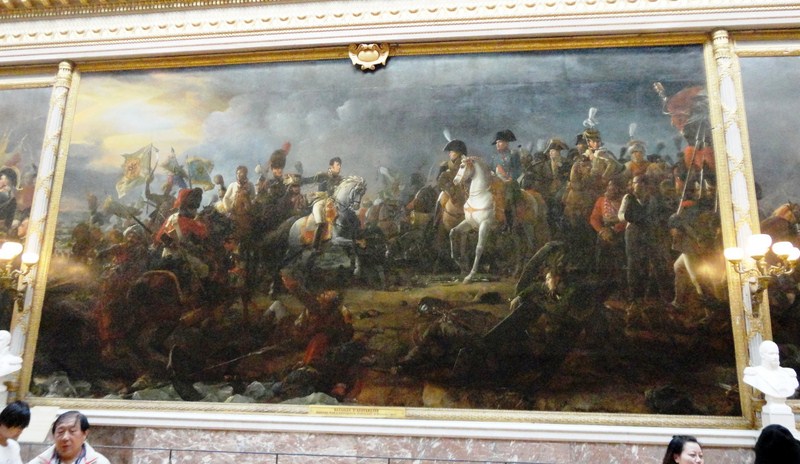
Battle of Austerlitz (François Gérard). Widely regarded as the greatest victory achieved by Napoleon, here the Grande Armée of France defeated a larger Russian and Austrian army led by Emperor Alexander I and Holy Roman Emperor Francis II (December 2, 1805). The Battle of Austerlitz brought the War of the Third Coalition to a rapid end, with the Treaty of Pressburg signed by the Austrians later in the month. The battle is often cited as a tactical masterpiece, in the same league as other historic engagements like Cannae or Gaugamela.
Its creation an idea of Louis-Philippe I, it was designed in 1833 and its construction started the same year. The gallery was solemnly inaugurated on June 10, 1837.
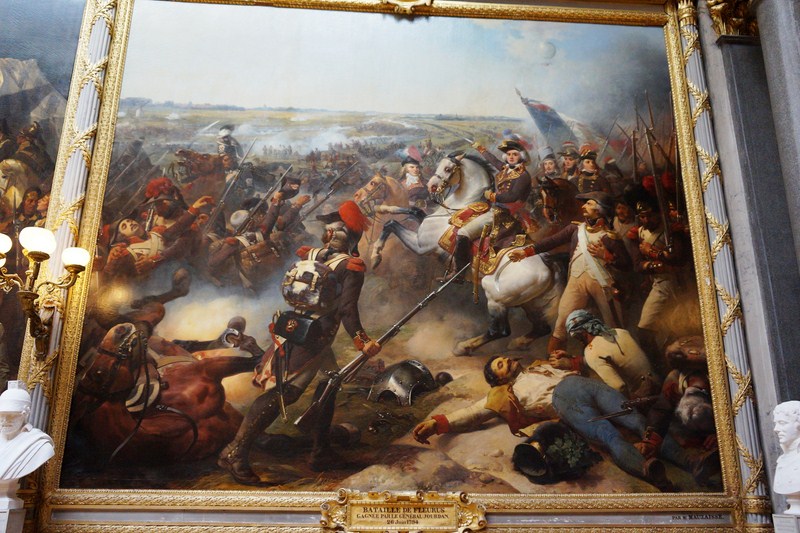
Battle of Fleurus (Jean-Baptiste Mauzaisse). This engagement (June 26, 1794), between the army of the First French Republic (under General Jean-Baptiste Jourdan) and the Coalition Army (Britain, Hanover, Dutch Republic, and Habsburg Monarchy), commanded by Prince Josias of Coburg, resulted in an Allied defeat that led to the permanent loss of the Austrian Netherlands and to the destruction of the Dutch Republic. The battle marked a turning point for the French army, which remained ascendant for the rest of the War of the First Coalition.
The gallery replaced apartments which had been occupied in the 17th and 18th centuries by Philippe I, Duke of Orléans (Louis XIV‘s brother) and his second wife, Elizabeth Charlotte of the Palatinate; Philippe II, Duke of Orléans (regent during Louis XV‘s minority) and his wife; Louis d’Orléans, Duke of Orléans (the regent’s son); Princess Maria Josepha of Saxony (1731–1767) as dauphine; Charles X of France (whilst Comte d’Artois) and Princess Élisabeth of France.
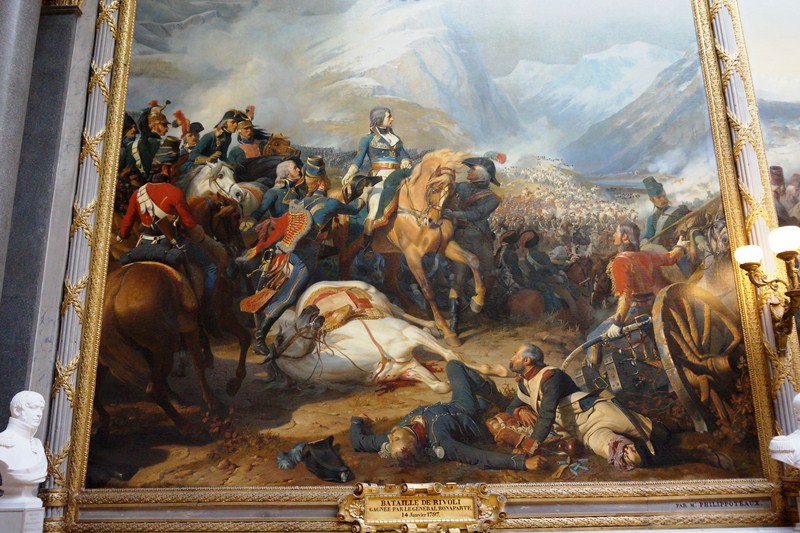
Battle of Rivoli (Henri Félix Emmanuel Philippoteaux). A key victory (January 14-15, 1797) in the French campaign in Italy against Austria, here Napoleon Bonaparte’s 23,000 Frenchmen defeated an attack of 28,000 Austrians under General of the Artillery Jozsef Alvinczi, ending Austria’s fourth and final attempt to relieve the Siege of Mantua. Rivoli further demonstrated Napoleon’s brilliance as a military commander and led to the French consolidation of northern Italy.
Its solemn decorative scheme, designed by Frédéric Nepveu and, almost certainly, with advice from architect Pierre-François-Léonard Fontaine, evokes the latter’s projects for the Grande Galerie in the Louvre during the Consulat and the Empire.
Check out “Louvre Museum – Grand Gallery“
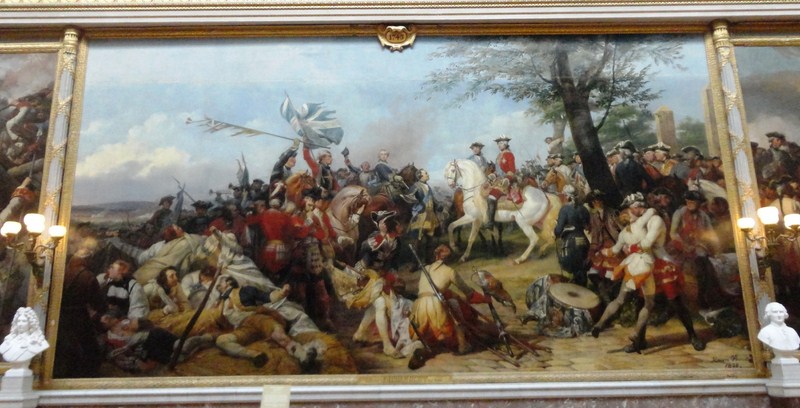
Battle of Fontenoy (Horace Vernet). A major engagement of the War of the Austrian Succession (May 11, 1745), was a battle fought 8 kms. outside Tournai (Belgium) by a French army of 50,000 under Marshal Saxe which defeated a Pragmatic Army of 52,000, led by the Duke of Cumberland.
Its solemn space, with finely decorated with marble and painted and gilded stuccos, features a wide cornice supporting a coffered painted ceiling lit up by glass, with entablatures supported and punctuated by an avant-corps of Corinthian columns along the length of the gallery. On the walls are 13 bronze tablets inscribed with the names of princes, admirals, constables, marshals and warriors killed or wounded whilst fighting for France.
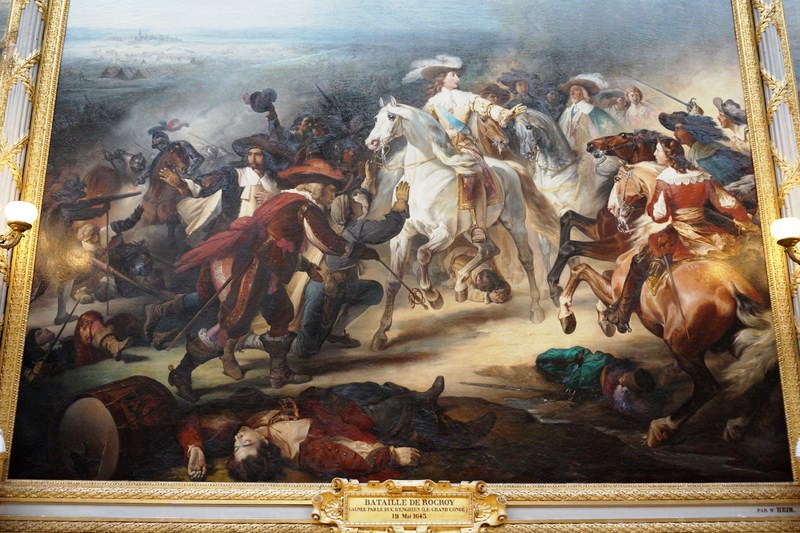
Battle of Rocroi (Francois Joseph Heim, 1834). Fought on May 19, 1643, this major engagement of the Thirty Years’ War was fought between a French army, led by the 21-year-old Duke of Enghien, and Spanish forces, under Gen. Francisco de Melo only five days after the accession of Louis XIV to the throne of France following his father’s death. Rocroi is regarded as the graveyard of the myth of invincibility of the Spanish Tercios, the terrifying infantry units that had dominated European battlefields for 120 years up to that point.
The main contents of the rooms are the 33 vast paintings showing major military events and the greatest battles that had influenced the history of France, some already in existence but mostly specially commissioned for the gallery between 1834 and 1845. All the dynasties (the Merovingians, Carolingians, Capetians, House of Valois, House of Bourbon,etc.) from the history of France are evoked.
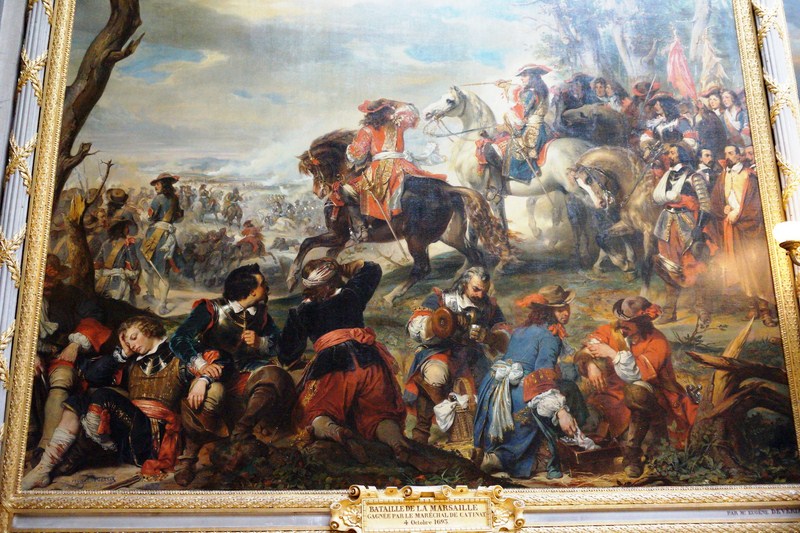
Battle of Marsaglia (Eugene Deveria). This battle, in the Nine Years’ War, was fought in Italy on October 4, 1693, between the French army of Marshal Nicolas Catinat and the army of the Grand Alliance under Duke Victor Amadeus II of Savoy. Here, the greatly superior regimental efficiency of the French, and Catinat’s minute attention to details in arraying them, gave the new marshal a victory that was a worthy pendant to Neerwinden.
Louis-Philippe’s skillfully incorporated depictions of the victories by the Revolution and the Empire had a simple message: France had built itself over the course of battles against enemies from both abroad and within; the country is henceforth glorious, at peace and ready to enter a new era built on peace and prosperity. Today it is still one of the most impressive examples of Louis Philippe’s project for Versailles and one of the finest examples of major museum projects of the 19th century.
The four largest paintings were commissions from previous regimes. The 9.58 m. by 5.10 m. Battle of Austerlitz, an oil on canvas by François Pascal Simon Gérard (1770–1837), was commissioned by Napoleon I for the ceiling of the Salle du Conseil d’État at the palais des Tuileries in Paris. Henry IV‘s Entry into Paris, also by Gérard, measures 5.1 m. by 9.58 m. The 5.1 m. by 9.58 m. Battle of Bouvines (1827) and the 5.1 m. by 9.58 m. Battle of Fontenoy (1828), both by Horace Vernet, were commissioned during the Restoration.
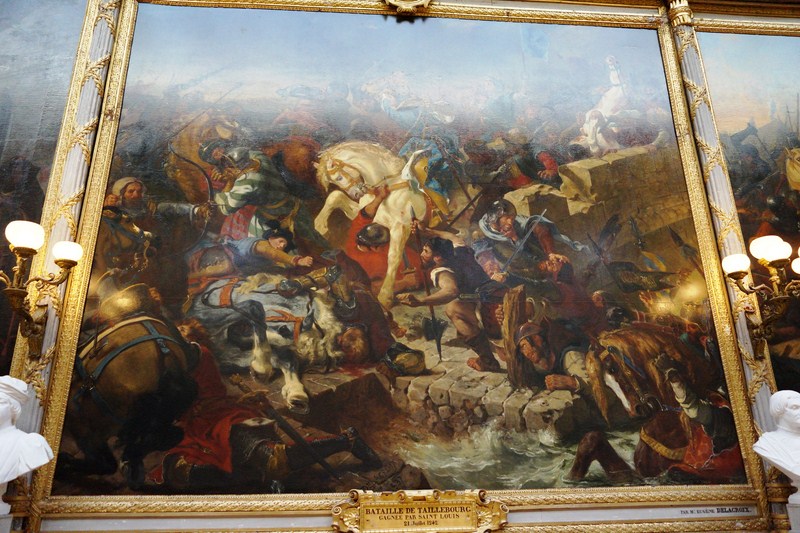
Battle of Taillebourg (Eugène Delacroix). This major medieval battle, fought in July 1242, was the decisive engagement of the Saintonge War. It pitted a French Capetian army, under the command of King Louis IX and his younger brother Alphonse of Poitiers, against forces led by King Henry III of England, his brother Richard of Cornwall and their stepfather Hugh X of Lusignan.
All the other works were created especially for the Gallery by great historical painters of the time including Jean Alaux, Francois Bouchot, Louis Charles Auguste Couder (1790-1873), Eugène Delacroix (1798–1863), Devéria Eugène (1805–1865), Eloi Firmin Feron (1802-1876), Fragonard son, Jean-Pierre Franque (1774–1860), François Joseph Heim (1787–1865), Charles-Philippe Larivière (1798–1876), Jean-Baptiste Mauzaisse, François-Édouard Picot (1786–1868), Ary Scheffer (1795–1858), Hendrik Scheffer, Henry Scheffer, Jean-Victor Schnetz, Henri Frederic Schopin and Charles de Steuben. A number of them were of questionable quality, but a few masterpieces, such as the Battle of Taillebourg by Eugène Delacroix, are displayed here.

Battle of Bouvines (Horace Vernet, 1827). Fought on July 27, 1214 near the town of Bouvines in the County of Flanders, it was the concluding battle of the Anglo-French War of 1213–1214. Here, a French army of approximately 7,000 men, commanded by King Philip Augustus, defeated an Allied army of approximately 9,000, commanded by Holy Roman Emperor Otto IV.
The 33 paintings, arranged chronologically, are:
- Battle of Tolbiac won by Clovis I over the Alamanni in 496. Artist: Ary Scheffer (1795–1858). Dimensions: 4.15 m. by 4.65 m.
- Battle of Poitiers (October 732) showing Charles Martel, Odo the Greatand Abd-el-Rahman. Artist: Charles de Steuben. Date: 1837. Dimensions: 5.42 m. by 4.65 m.
- Charlemagne Receiving the Submission of Widukind, King of the Saxons at Paderborn in 785. Artist: Ary Scheffer (1795–1858). Dimensions: 4.65 m. by 5.42 m.
- Count Eudes Defending Paris against the Normans in 885. Artist: Jean-Victor Schnetz. Date: commissioned by Louis-Philippe in 1834, signed 1837. Dimensions: 5.42 m. by 4.65 m.
- Philippe-Auguste before the Battle of Bouvines (July 27 1214). Artist: Horace Vernet (1789–1863). Date: 1827. Medium: Oil on canvas, Dimensions: 5.1 m. by 9.58 m.
- Battle of Taillebourg (July 21, 1242) won by Saint Louis. Artist: Eugène Delacroix (1798–1863). Date: 1837. Dimensions: 4.89 m. by 5.54 m.
- Battle of Mons-en-Pévèle (August 18, 1304) won by Philip the Fairagainst the Flemish Army. Artist: Charles-Philippe Larivière (1798–1876). Date: ca. 1839. Dimensions: 4.65 m. by 5.43 m.
- Battle of Cassel (August 23, 1328) won by Philippe de Valois, showing Philip and Nicolas Zonnekin. Artist: Hendrik Scheffer. Date: 1837. Dimension: 5.43 m. by 4.65 m.
- Battle of Cocherel (May 16, 1364), near Évreux, won by Bertrand du Guesclinover the troops of Charles II of Navarre. Artist: Charles-Philippe Larivière (1798–1876). Dated: ca. 1837. Dimension: 4.25 m. by 2.6 m.
- The Entry of Joan of Arc into Orleans (May 8, 1429. Artist: Henry Scheffer. Date: 1843. Medium: Oil on canvas.
- Battle of Castillon (July 17 1453) won by the Comte de Dunois over the English forces under Lord Talbot. Artist: Charles-Philippe Larivière (1798–1876). Medium: Oil on canvas.
- Battle of Marignan (September 14, 1515) won by Francis I of France, showing Francis ordering his troops to stop pursuing the Swiss. Artist: Alexandre-Évariste Fragonard (1780–1850). Dimensions: 4.65 m. by 5.43 m.
- Capture of Calais(January 9, 1558) by Francis, Duke of Guise. Artist: François-Édouard Picot (1786–1868). Dimensions: 4.65 m. by 5.43 m.
- Henry IV‘s Entry into Paris (March 22, 1594). Artist: François Pascal Simon Gérard (1770–1837). Dimensions: 5.1 m. by 9.58 m.
- Battle of Rocroi (May 19, 1643), the Duc d’Enghien ordering his troops to stop fighting the Spanish, who have come to him to surrender. Artist: François Joseph Heim (1787–1865). Date: 1834. Dimensions: 4.65 m. by 5.43 m.
- Battle of Lens (August 20, 1648), victory of the Grand Condé over the Spanish troops commanded by Archduke Leopold. Artist: Jean-Pierre Franque (1774–1860). Date: ca. 1835. Dimensions: 4.65 m. by 5.43 m.
- Battle of the Dunes (June 1658) at the Siege of Dunkirk, won by the Maréchal de Turenne over the Spanish. Artist: Charles-Philippe Larivière (1798–1876). Date: 1837. Dimensions: 4.65 m. by 5.43 m.
- Capture of Valenciennes (March 17, 1677) by Louis XIV. Artist: Jean Alaux. Medium: Oil on canvas, Date: 1837. Dimensions: 4.65 m. by 4.15 m.
- Battle of Marsaglia (October 4, 1693) won by Nicolas Catinat over the Piedmontese troops of Victor Amadeus II of Sardinia assisted by Prince Eugene of Savoy. Artist: Devéria Eugène (1805–1865). Date: 1837. Dimensions: 4.65 m. by 5.43 m.
- Battle of Villaviciosa (December 10, 1710) won by Louis Joseph, Duke of Vendôme over Count Guido Starhemberg. Artist: Jean Alaux, known as Le Romain (1786–1864). Date: 1836. Dimensions: 4.65 m. by 5.43 m.
- Battle of Denain (July 24, 1712) won by Claude Louis Hector de Villarsover Prince Eugene of Savoy. Artist: Jean Alaux, known as Le Romain (1786–1864). Date: 1839. Dimensions: 4.65 m. by 5.43 m.
- The Battle of Fontenoy (May 11, 1745) showing Maurice de Saxe presenting the captured British and Dutch prisoners and colors to Louis XV and the dauphin. Artist: Horace Vernet (1789–1863). Date: 1828. Dimensions: 5.1 m. by 9.58 m.
- Battle of Lawfeld (July 2, 1747) shows Louis XV pointing out the village of Lawfeld to Maurice de Saxe. Artist: Pierre Lenfant (1704–1787). Dimensions: 2.75 m. by 2.5 m.
- Siege of Yorktown. Général Rochambeau and George Washington give the final orders to attack (October 1781). Artist: Louis Charles Auguste Couder (1790-1873). Date: 1836. Dimension:65 m. by 5.43 m.
- Battle of Fleurus (June 26, 1794) won by Jean-Baptiste Jourdan over the Austrian forces led by the princes of Coburg and Orange. Artist: Jean-Baptiste Mauzaisse. Date: 1837. Medium: Oil on canvas. Dimensions: 4.65 m. by 5.43 m.
- Battle of Rivoli (January 14, 1797) won by Napoleon Bonaparte. Artist: Henri Félix Emmanuel Philippoteaux (1798–1880). Medium: Oil on canvas. Date: 1844. Dimensions: 4.65 m. by 5.43 m.
- Second Battle of Zürich (September 25, 1799), showing André Masséna, the comte Nicolase, Charles Oudinot and Count Honoré Charles Reille. Artist: François Bouchot. Medium: oil on canvas. Date: Commissioned by Louis-Philippe in 1835, signed 1837. Dimension: 5.43 m. by 4.65 m.
- Battle of Hohenlinden (December 3, 1800) showing Jean Victor Moreau, Michel Ney, Emmanuel de Grouchy (1835). Artist: Henri Frederic Schopin. Date: 1836. Medium: Oil on canvas. Dimensions: 4.65 m. by 5.43 m.
- Battle of Austerlitz (December 2, 1805) – showing Napoleon accompanied by Jean Rapp, oil on canvas, sketch after an original that in 1846 was in the Paillet collection, commissioned by Napoleon I for the ceiling of the Salle du Conseil d’État at the palais des Tuileries in Paris. Dimensions: 9.58 m. by 5.10 m.
- Battle of Friedland (June 14, 1807) – showing Napoleon I and Count Nicolas Charles Oudinot. Artist: Horace Vernet. Dimensions: 5.43 m. by 4.65 m.,
- Battle of Jena (October 14 1806) – showing Napoleon I, Joachim Murat and Louis Alexandre Berthier. Artist: Horace Vernet. Date: 1836. Dimensions: 5.43 m. by 4.65 m.
- Battle of Wagram (July 6, 1809) – showing Napoleon I and the duc d’Istrie. Artist: Horace Vernet. Dimensions: 5.3 m. by 4.65 m.
The gallery, also designed as a Pantheon to national glory, also features a series of 80 busts of officers killed in combat, as well as tables in bronze bearing the names of princes, constables, Maréchals and admirals also killed or wounded for France.
The busts are placed on supports against the columns and between the paintings. The 80 busts on display are those of:
- Joseph-Antoine, prince Poniatowski – Marshal of the Empire (1762–1813). Artist: François-Augustin Caunois (1787–1859).
- Adolphe Édouard Casimir Joseph Mortier (Duke of Trévise) – Marshal of the Empire (1768–1835). Artist: Théophile-François Marcel Bra(1797–1863).
- Jean-Baptiste Bessières (Duke of Istries) – Marshal of the Empire (1768–1813). Artist: François Masson (1745–1807).
- Henri LXI, Prince de Reuss-Schleiz – Général of Brigade in French service (1784–1813). Artist: Charles-François Lebœuf.
- Simon de Montfort, 5th Earl of Leicester – Duke of Narbonne (c 1150–1218). Artist: Jean-Jacques Feuchère(1807–1852).
- Robert d’Artois – son of Otto IV and Mahaut d’Artois (died 1317). Artist: Jean-Jacques Flatters (1786–1845).
- Hugues Quieret – French admiral, died 1340. Artist: Charles Émile Seurre(1798–1858).
- Nicolas Béhuchet – French admiral, died 1340. Artist: Bernard Seurre (1795–1867).
- Alexandre-Antoine Hureau – Comte de Sénarmont, Général of Division (1732–1810). Artist: Antoine Laurent Dantan the Elder (1798–1878).
- César Charles Étienne, comte Gudin – Général of Division (1768–1812). Artist: Louis-Denis Caillouette (1790–1868)
- Walter VI of Brienne, Duke of Athens– Constable of France in 1356 (died 1356). Artist: Justin-Marie Lequien (1796–1882).
- Antoine Louis Charles – Comte Lasalle, Général of Division (1775–1809). Artist: Auguste Taunay (1768–1824).
- Peter I – Duke of Bourbon(c 1311–1356). Artist: Louis-Eugène Bion (1807–1860).
- Jean-Baptiste Cervoni – Général of Division (1765–1809). Artist: Pietro Cardelli (1776–1822).
- Jean Lannes(duc de Montebello) – Marshal of the Empire (1769–1809). Artist: François Masson (1745–1807).
- Nicolas-Bernard – Général-baron Guiot de Lacour, général of division (1771–1809). Mortally wounded at Wagram (wearing the cross of the Légion d’Honneur and the cross of the Ordre de Saint-Henri of Saxony). Artist: Jean-Baptiste Joseph Debay (1802–1862)
- André Bruno de Frévol – Comte de La Coste, général of brigade (1775–1809). Artist: Claude Michel (known as Clodion) (1738–1814). Artist: Claude Michel Clodion.
- Prigent de Coëtivy– Sire de Coëtivy, Admiral of France, killed at the Siege of Cherbourg in 1450. Artist: Honore Husson.
- Charles the Bold, duke of Burgundy(1433–1477). Artist: Charles-François Lebœuf (1792–1865), Nanteuil, also known as Nanteuil-Lebœuf.
- Jacques Desjardin – Général of Division (1759–1807), killed at the Battle of Eylau. Artist: Antoine Laurent Dantan (1798–1878)
- Joseph Sécret Pascal-Vallongue – Général of Brigade (1763–1806). Artist: Jean-Baptiste-Joseph Debay (1779–1863).
- John Stewart – Earl of Buchan, Constable of France, killed at the Battle of Verneuilin 1424. Artist: Charles Rene Laitie.
- Jacques Dampierre de Châtillon – Admiral of France, killed at the Battle of Agincourt in 1415. Artist: Andre Eugene Oudine.
- Charles de Blois – killed at Auray in 1364. Artist: Jacques Augustin Dieudonne.
- André de Montalembert– Seigneur d’Essé, killed at the Siege of Terouanne in 1555. Artist: Jean Louis Jaley.
- Piero Strozzi – Marshall of France, killed at Thionville in 1553. Artist: Jean Louis Jaley.
- Anne – Duc de Montmorency (1572–1567). Artist: James Pradier.
- Jacques d’Albon – Seigneur de Saint-André – Marshall of France (c 1505–1562). Artist: Jean-François-Théodore Gechter (1796–1844).
- Manassès de Pas, marquis de Feuquières. Lieutenant-Général of the Armies of the King. Killed at Thionvillein 1640. Artist: Philippe Joseph Henri Lemaire.
- Armand de Maillé – Marquis de Brézé, Duc de Fronsac, Admiral of France, killed at the Battle of Orbetello in 1646. Artist: Jean-Francois Legendre-Heral.
- Jean Baptiste Budes – Baron de Guébriant, Marshall of France, killed at Rothweil, 1643. Artist: Jean-Pierre Cortot.
- Jacques Marquis de Castelnau – Marshall of France, killed at Dunkirkin 1653. Artist: Jean-Bernard Deseigneur.
- Jean de Gassion– Marshall of France, killed at Lens in 1547. Artist: Jean Alaux
- Jacques de Rougé – Marquis du Plessis-Bellière, Lieutenant-Général of the Armies of the King, killed at Castellamare in 1654. Artist: Jean Bernard Duseigneur.
- Anthony of Burgundy – Duke of Brabant, Dukeof Limburg, killed at the battle of Agincourt in 1415. Artist: Pierre Simart.
- Charles de Créquy, Marshall of France, killed before the fort of Breme, 1636. Artist: Davitan the Younger.
- Jean du Caylarde – Marquis de Toiras, killed at Fontanetoin the Milanais, 1636. Artist: Louis-Denis Caillouett.
- François, Duke of Beaufort – Admiral of France, killed at the Siege of Candiain 1669. Artist: Michel-Louis Victor Mercier.
- Henri de La Tour d’Auvergne– Vicomte de Turenne, Marshall of France, killed near Saltzbach in 1675. Artist: Jean-Jacques Flatters (1786–1845).
- Pierre Claude Berbier du Metz – Lieutenant-Général of the Armies of the King, killed at the Battle of Fleurus in 1690. Artist: François Jouffroy.
- Nicolas de la Brousse– Comte de Vertillac, marshal general of the king’s camps and armies, killed near Bossu. 1693. Artist: Joseph-Stanislaus Lescorne.
- Charles Paris d’Orléans –Duc de Longueville, killed during the Rhine crossing in 1672. Artist: François Jouffroy.
- Jean-Baptiste Cassagnet– Marquis de Tilladet, Lieutenant-Général of the Armies of the King, killed at Steenkerque in 1692. Artist: Jean-Baptiste-Joseph Debay (1779–1863).
- Claude-Louis-Constant Corbineau – général of brigade (1772–1807). Artist: Philippe Joseph Henri Lemaire(1798–1880).
- Jean de Vienne – Admiral of France, killed at the Battle of Nicopolisin 1396. Artist: Francisque Duret (1804–1865).
- Gaston of Foix – Duke of Nemours, killed at the battle of Ravennain 1512. Artist: Jacques Augustin Dieudonne.
- Jean d’Aumont –Maréchal de France, killed at Combourg in Brittany, 1595. Artist : Auguste-Alexandre Dumont (1801–1884), known as Auguste or Augustin Dumont
- André Baptiste de Brancas – Seigneur de Villars, Admiral of France, killed at the Siege of Doullens in 1595. Artist: Victor Thérasse.
- James I – Count of La Marche – Constable of France, killed at the Battle of Brignaisin 1361. Artist: Nicolas Bernard Raggi.
- Louis d’Armagnac – Duke of Nemours, killed at Gérignole, 1503. Artist: Francois Rude
- Pierre du Terrail– Seigneur de Bayard, killed at Rebec, 1524. Artist: Anonymous.
- Guillaume Gouffier de Bonnivet– Admiral of France, killed at Pavia in 1525. Artist: Francois Lanno.
- Jacques II de Chabannes de La Palice(known as La Palice) – Marshal of France, killed at Pavia in 1525. Artist: Jean Bernard Duseigneur.
- Jean de Bourbon – Comte de Soissons, killed at Saint-Quentin in 1557. Artist: Jean-Bernard Duseigneur.
- Charles de La Rochefoucauld – Comte de Randan. Artist: Sylvestre-Joseph Brun
- Antoine de Bourbon – King of Navarre. Artist: Joseph Marius Ramus.
- Anne – Duc de Joyeuse. Artist: Isidore Hippolyte Nicolas Brion.
- Claude de Loraine – Duc d’Aumale, Colonel of the Frenchcavalry. Artist: Joseph Stanislas.
- Fernand de Nogaret – Seigneur de Lavalette. Artist: Louis Desprez.
- Pierre-François, Marquess of Rougé. Lieutenant-Général of the Army of the King, killed at Villinghausen in 1761. Artist: Jean-Baptisten Joseph Debay.
- Jacques Christophe Coquille Dugommier – Commander-in-Chief, killed at the Battle of the Black Mountain in 1794 Artist: Antoine-Denis Chaudet.
- Amédée Emmanuel François Laharpe. Général of Division, killed in the crossing of the River Po in 1796. Artist: Félix Lecomte.
- Jean Gilles André Robert – Général of Brigade, killed at the Battle of Arcolein 1796. Artist: Gois Fils.
- Martial Beyrand – Général of Brigade, killed at Castiglionein 1796. Artist: Charles-Louis Corbet.
- Charles Abattucci – Général of Division, killed at Huningue in 1796. Artist: Vital Gabriel Dubray.
- Jean-Jacques Causse – Général of Brigade, killed at Dego in 1796. Artist: Jacques-Edme Dumont.
- Pierre Banel – Général of Brigade, killed at Cossaria, 1796. Artist: Lorenzo Bartolini.
- Louis Marie de Caffarelli du Falga – Général of Division, killed at the Siege of Acrein 1799. Artist: François Masson (1745–1807)
- Barthélemy Catherine Joubert – Général-in-Chief of the Army of Italy, killed at the Battle of Noviin 1799. Artist: Louis-Simon Boizot.
- Dominique Martin Dupuy – Général of Brigade, killed in Cairo in 1798. Artist: Philippe-Laurent Roland.
- François Paul Brueys – Comte d’Aigalliers, Vice-Admiral, killed at the Battle of the Nilein 1799. Artist: Jean-Jacques Flatters (1786–1845).
- Louis Marie, vicomte de Noailles – Général of Brigade, died of wounds in Havana in 1804. Artist: Dantan Antoîné Laurent.
- Jean Louis Debilly. Général of Brigade, killed at the Battle of Jena in 1806. Artist: Jean-Baptiste-Joseph Debay (1779–1863).
- Jean Baptiste Kléber– Général-in-Chief (1753–1800). Artist: Philippe Joseph Henri Lemaire (1798–1880).
- François Louis de Morlan – killed at the Battle of Austerlitzin 1805. Artist: Julie Charpentier.
- Béat Jacques de la Tour Chatillon– Comte de Zurlauben, Lieutenant-Général of the Army of the King, killed at Hochstett in 1704. Artist: François Jouffroy.
- Ferdinand, Comte de Marsin – Marshall of France, killed at Turin in 1706. Artist: François Jouffroy.
- Louis Joseph de Saint Véran, Marquis de Montcalm – Lieutenant-Général of the Army of the King, killed at the Battle of the Plains of Abrahamin 1759. Artist: Francisque Duret.
- Armand de Gontaut – Baron de Biron, Marshall of France, killed at Épernayin 1592. Artist: Jean-Baptiste-Joseph Debay (1779–1863)
- James FitzJames – 1st Duke of Berwick, marshal (1671–1734). Artist: Antoine-Laurent Dantan the Elder (1798–1878).
Today, the Royal Serenade and King’s Tour take place in the Gallery of Great Battles.
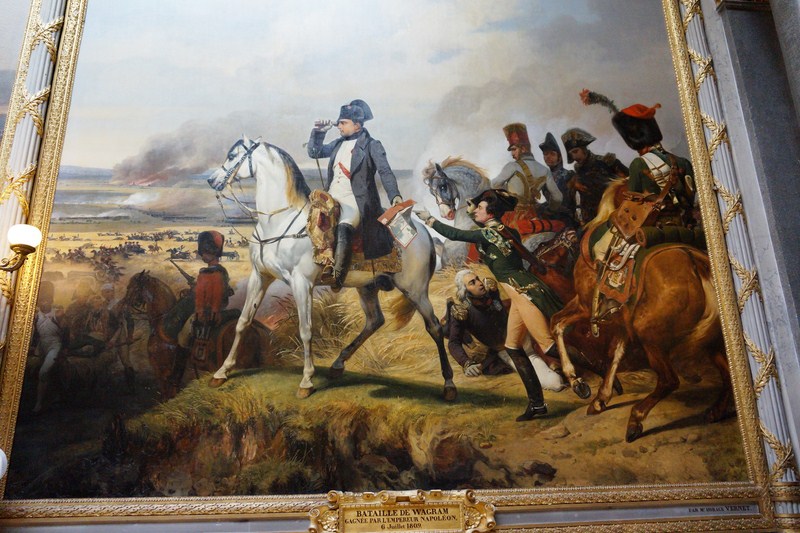
Battle of Wagram (Horace Vernet). Fought July 5-6, 1809), this military engagement of the Napoleonic Wars ended in a costly but decisive victory for Emperor Napoleon Bonaparte’s French and allied army against the Austrian army under the command of Archduke Charles of Austria-Teschen. The battle led to the breakup of the Fifth Coalition, the Austrian and British-led alliance against France.
Gallery of Great Battles: South Wing, Chateau De Versailles, Place d’Armes, 78000 Versailles, France. Tel: +33 1 30 83 78 00. Website: www.chateauversailles.fr. Open daily (except on Mondays and May 1), from 9:00 AM to 6:30 PM. Last admission is 6 PM while the ticket office closes at 5.45 PM. The estate of Trianon and the Coach Gallery only open in the afternoon while the Park (7 AM to 8:30 PM) and Gardens (8 AM to 8.30 PM, last admission: 7 PM) are open every day. Access to the Gardens is free except on days of fountains shows. You can access the estate of Trianon through the Gardens or through the city. The Petit Trianon is only possible via the Grand Trianon.
Admission: 27 € for Passport with Timed Entry (days with Musical Fountains Shows or Musical Gardens), 20 € for Passport with Timed Entry (without musical fountains show or musical gardens), 12 € for Estate of Trianon ticket(without Musical Fountains Show or Musical Gardens), 10 € for Passport with Timed Entry (free admission, days with Musical Fountains Show or Musical Gardens), 9,50 € for Musical Fountains Show ticket, 8,50 € for Musical Gardens ticket, 28 € for the Fountains Night Show.
How to Get There: The cheapest option for reaching Versailles is by train. There are three train stations in Versailles. RER line C arrives at Versailles Château – Rive Gauche train station, the closest one of the Palace (just 10 minutes’ walk to the Palace). SNCF trains from Gare Montparnasse arrive at Versailles Chantiers train station, which is 18 minutes on foot to the Palace. SNCF trains from Gare Saint Lazare arrive at Versailles Rive Droite train station, 17 minutes on foot to the Palace. RER C and SNCF train times are available on www.transilien.com
Versailles Palace – 1792 Room (France)
The 1792 Room, a transition room in the Versailles Palace devoted to September 1792 (a pivotal year of the French Revolution) when the Republic was proclaimed, was developed for the History of France Museum from what had formerly been known as the Room of the Merchants of the Court during the reign of Louis XV.
Check out “Versailles Palace“
It presages the messages of the Gallery of Battles and, beyond it, the 1830 Room, in a trilogy that represents King Louis Philippe’s response to the Hall of Mirrors built by his ancestor, Louis XIV, surrounded by the War and Peace Rooms.
Check out “Versailles Palace – Hall of Mirrors” and “Versailles Palace – Grand Gallery”
The only remnant of the rooms that Louis-Philippe I devoted to the French Revolution, it offers the keys to understanding the king’s political and historic project.
The 1792 Room marks both the end of a world (the French monarchy fell on August 10, 1792) and the beginning of a new era full of hopes as well as worries as the European monarchies were united against France, which found, within itself, the driving forces that would unite to defend it.
In this room, there are paintings of some of the most emblematic battles of the Revolution that evoke the call to arms to defend “the imperiled nation.”
They include the September 20, 1792 Battle of Valmy (Mauzaisse after Horace Vernet, 1826) and the November 6, 1792 Battle of Jemappes (Henry Scheffer after Horace Vernet, 1821) in which Louis-Philippe I (then known as the Duke of Chartres), participated along with his younger brother Antoine Philippe (the Duke of Montepensier). There’s also The National Guard of Paris Leaves to Join the Army in September 1792 by Léon Cogniet.
Louis-Philippe I also gathered portraits of the many military commanders and heroes of the Revolutionary Wars and Empire Wars, wearing the uniforms and badges of their ranks, who led France to victory such as François Christophe de Kellermann, Charles François Dumouriez, Nicolas Luckner, are featured alongside veterans of the American Revolutionary War Jean-Baptiste Donatien de Vimeur, comte de Rochambeau and Gilbert du Motier, Marquis de Lafayette.
Lining the archways around the windows are portraits of young officers who would become future generals and marshals of the Consulate and the Empire while above the entrance, the portrait of a young Napoleon has pride of place.
There is a subtle hierarchy between the portraits, with King Louis-Philippe I presenting himself as a Revolutionary fighter (being a participant in the two abovementioned battles), heir of the Enlightenment and a proponent of new ideas.
1792 Room: Chateau De Versailles, Place d’Armes, 78000 Versailles, France. Tel: +33 1 30 83 78 00. Website: www.chateauversailles.fr. Open daily (except on Mondays and May 1), from 9:00 AM to 6:30 PM. Last admission is 6 PM while the ticket office closes at 5.45 PM. The estate of Trianon and the Coach Gallery only open in the afternoon while the Park (7 AM to 8:30 PM) and Gardens (8 AM to 8.30 PM, last admission: 7 PM) are open every day. Access to the Gardens is free except on days of fountains shows. You can access the estate of Trianon through the Gardens or through the city. The Petit Trianon is only possible via the Grand Trianon.
Admission: 27 € for Passport with Timed Entry (days with Musical Fountains Shows or Musical Gardens), 20 € for Passport with Timed Entry (without musical fountains show or musical gardens), 12 € for Estate of Trianon ticket(without Musical Fountains Show or Musical Gardens), 10 € for Passport with Timed Entry (free admission, days with Musical Fountains Show or Musical Gardens), 9,50 € for Musical Fountains Show ticket, 8,50 € for Musical Gardens ticket, 28 € for the Fountains Night Show.
How to Get There: The cheapest option for reaching Versailles is by train. There are three train stations in Versailles. RER line C arrives at Versailles Château – Rive Gauche train station, the closest one of the Palace (just 10 minutes’ walk to the Palace). SNCF trains from Gare Montparnasse arrive at Versailles Chantiers train station, which is 18 minutes on foot to the Palace. SNCF trains from Gare Saint Lazare arrive at Versailles Rive Droite train station, 17 minutes on foot to the Palace. RER C and SNCF train times are available on www.transilien.com.
Versailles Palace – Coronation Room (France)
At the exit of the Queen’s Grand Apartment is the Coronation Room, the large space adjoining the royal apartments. In 1672, it served as the palace’s second chapel but, in 1682, was changed into the Great Guard’s Room, until 1789, “for both the King and the Queen.” Every year, on Holy Thursday, the King would wash, then kiss the feet of 13 impoverished children. On April 13, 1771, Louis XV held a lit de justice in this room, during which he announced the dissolution of the parliaments.
Check out “Versailles Palace” and “Versailles Palace – Queen’s Grand Apartment”
However, the name of the room has nothing to do with the Bourbon monarchs. In 1833, it became a room devoted to the glory of Napoleon Bonaparte, First Consul and then Emperor of the French, and the plan was to display the greatest paintings of his reign which could not be placed anywhere else in the palace – the two incredibly large and prestigious paintings commissioned from Jacques-Louis David.
The first, The Coronation of the Empress Josephine by Napoleon on December 2, 1804 (1805-1808), is a second copy that David painted, for a group of American businessmen, in Paris and then in Brussels in 1808-1822. Throughout the 19th century, the painting was shown across the United States and Europe.
In 1947, the painting was acquired by Versailles and, the following year, was placed in this room, thus recreating this beautiful space as imagined by King Louis-Philippe I. The original painting was moved from Versailles to the Louvre in Paris in 1889. Taking up an entire wall, it commemorates the ceremonies celebrating Napoleon’s coronation as Emperor of the French.
The Distribution of the Eagle Standards on December 5, 1804 (1808-1810), commemorates the Army swearing allegiance to Napoleon after the distribution of the imperial eagle standards at the Champ de Mars in Paris..
The combined talents of palace architect, Frédéric Nepveu, sculptor Jean-Baptiste Plantar (trophies on the wood paneling), and the workshop of painter Jean Alaux (the ceiling arch) created the decor that serves as a backdrop to these works.
Aside from David’s paintings, there is also the enormous Battle of Abukir on 25 July 1799 (1806) by Antoine-Jean Gros. Commissioned by Joachim Murat (the emperor’s brother-in-law), when he was King of Naples, it commemorates one of the most memorable cavalry charges, during the Egypt campaign, of Napoleon’s youth.
The room’s Napoleonic program included other works as well. The ceiling, remarkably raised and gilded, all on the order of Louis-Philippe, features the Allegory of 18 Brumaire (November 9, 1799) by Antoine-Francois Callet. Also called France Saved, it symbolizes Napoleon Bonaparte’s seizure of power. Above the door are the four allegories (The Warrior’s Courage, Genius Rising Despite Desire, Constancy, and Clemency Leaning on Force) by François Gérard.
Between the windows are four portraits – General Bonaparte, general-in-command of the Army of in Italy, by Rouillard; Napoleon I, Emperor of the French, by Alexandre Dufay, known as Casanova (a painting from that time, adapted here); a medallion of Josephine and Emperor Napoleon by Robert Lefèvre and the two Empresses Joséphine de Beauharnais and Marie-Louise von Habsburg, by Dedreux-Dorcy.
In the center of the room stands the Column from the German Campaign. Also called the “Austerlitz Column,” it was commissioned by Napoleon from the Sèvres Royal Porcelain Manufactory to commemorate his first imperial victories. One of the masterpieces of Sèvres porcelain production during the Empire, it was was created in collaboration with Brongniart (drawing), Bergeret (painting) and Thomire, Duterme and Co. (bronze mounting) and completed in 1807. The following year, it was placed in the State Apartments at the Tuileries Palace (Palais des Tuileries).
Coronation Room: Chateau De Versailles, Place d’Armes, 78000 Versailles, France. Tel: +33 1 30 83 78 00. Website: www.chateauversailles.fr. Open daily (except on Mondays and May 1), from 9:00 AM to 6:30 PM. Last admission is 6 PM while the ticket office closes at 5.45 PM. The estate of Trianon and the Coach Gallery only open in the afternoon while the Park (7 AM to 8:30 PM) and Gardens (8 AM to 8.30 PM, last admission: 7 PM) are open every day. Access to the Gardens is free except on days of fountains shows. You can access the estate of Trianon through the Gardens or through the city. The Petit Trianon is only possible via the Grand Trianon.
Admission: 27 € for Passport with Timed Entry (days with Musical Fountains Shows or Musical Gardens), 20 € for Passport with Timed Entry (without musical fountains show or musical gardens), 12 € for Estate of Trianon ticket(without Musical Fountains Show or Musical Gardens), 10 € for Passport with Timed Entry (free admission, days with Musical Fountains Show or Musical Gardens), 9,50 € for Musical Fountains Show ticket, 8,50 € for Musical Gardens ticket, 28 € for the Fountains Night Show.
How to Get There: The cheapest option for reaching Versailles is by train. There are three train stations in Versailles. RER line C arrives at Versailles Château – Rive Gauche train station, the closest one of the Palace (just 10 minutes’ walk to the Palace). SNCF trains from Gare Montparnasse arrive at Versailles Chantiers train station, which is 18 minutes on foot to the Palace. SNCF trains from Gare Saint Lazare arrive at Versailles Rive Droite train station, 17 minutes on foot to the Palace. RER C and SNCF train times are available on www.transilien.com.
Versailles Palace – King’s Grand Apartment (France)
The private apartments of the King (petit appartement du roi), the heart of the chateau; is a suite of rooms that were reserved for the private use of the king. It was accessed, from the Hall of Mirrors, from the Oeil de Boeuf antechamber past the Guardroom and the Antechamber of the Grand Couvert.
Check out “Versailles Palace,” “Versailles Palace – Hall of Mirrors” and “Versailles Palace – Queen’s Grand Apartment”
These rooms were set aside for the personal use of Louis XIV in 1683 while his successors, Louis XV and Louis XVI, who both drastically modified and remodeled these rooms for their personal use, used these rooms for official functions such as the ceremonial lever (“waking up”) and the coucher (“going to bed”) of the monarch, which were attended by a crowd of courtiers.
The King’s bedchamber, originally just a salon called the State Drawing Room, had been used by Queen Marie-Thérèse d’Autriche. After her death in 1701, Louis XIV, frustrated by the small size of his rooms (which could barely contain all the courtiers in attendance when he got up and when he went to bed), took it over for use as his own bedroom , knocking down the wall and combine the two rooms into one. Moving his bedchamber into its current location, the large room covered nearly 90 sq. m. and was situated in the center of the eastern façade of the Marble Courtyard.
Three tall doors, at the end of the room leading to the Hall of Mirrors, were sealed. Above these, Nicolas Coustou created the allegorical carved relief entitled France watching over the Sleeping King, which hangs over the bed. Decorations include several paintings set into the paneling (including a self-portrait of Antony Van Dyck).
As in all royal residences, the King’s Grand Apartment contained the customary succession of rooms (a Guard Room, two antechambers, a chamber and a cabinet) where access was subject to strict hierarchy and controlled by etiquette.
Beyond them was the King’s Chamber, the most important and symbolic room in the Royal Apartment. During the day, it was used during the king’s “getting up” and “going to bed” ceremonies, when he dined in private, and when he received certain courtiers or ambassadors. As a matter of principle, no one could enter his chamber unless invited. On September 1, 1715, after a reign of 72 years, the king died in this room.
On October 6, 1789, from the balcony of this room, Louis XVI and Marie-Antoinette, joined by the Marquis de Lafayette, looked down on the hostile crowd in the courtyard, shortly before the King was forced to return to Paris.
The King’s Guard Room, marking the entrance to the King’s Apartment, was where the king’s guards (changed over every 24 hours) were stationed to ensure the sovereign’s protection. During the day their camp beds were folded up and stowed away behind screens. In tribute to the room’s role, it’s deliberately understated, little sculpted decoration contains references to fighting. The Battle featuring the king’s guards (1684), a painting by Parrocel that hangs over the fireplace, honors the guards.
As we continued through the apartment, the decoration became more elaborate. The Antechamber of the Great Dining was where, every evening from 1690 (after the death of Marie-Thérèse d’Autriche and the Dauphine), Louis XIV used to dine in public on a table laid in front of the fireplace and sitting with his back to the hearth. The room is decorated with a series of 11 battle paintings by Joseph Parrocel, and a 12th depicting the Battle of Arbela, by Guillaume Courtois.
The Bull’s Eye Antechamber, the second antechamber in the royal apartment, was named after the circular window, on the southern side, which brings light into the room. This room, originally divided into two by a partition wall, was composed of the antechamber and the King’s Chamber, in which the bed was placed in the left-hand corner next to the current fireplace.
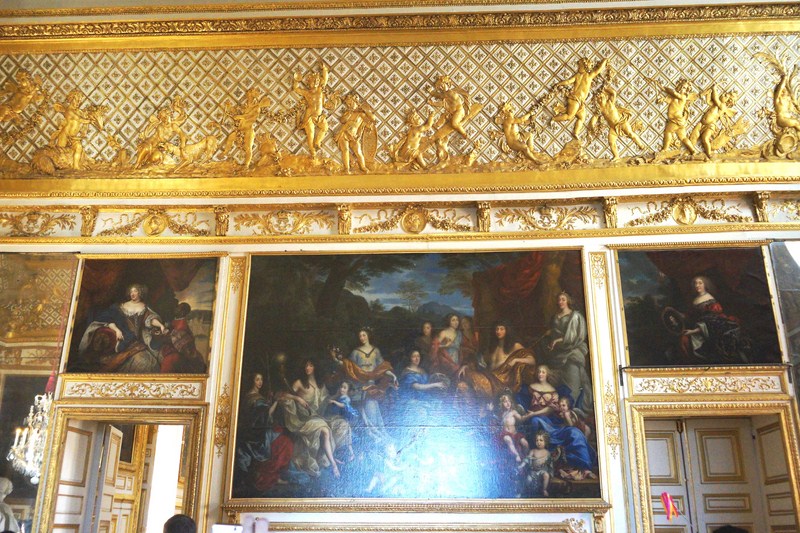
At the center is the painting of King Louis XIV and his Family (Jean Nocret, oil on canvas, 1670). Here they are portrayed as Roman gods.
Occupying a strategic position in the Royal Apartment, the Bull’s Eye Antechamber leads to the King’s Chamber to the north. To the west, the tall glass windows open directly onto the Hall of Mirrors, enabling courtiers to enter and leave the King’s Apartment. A door in the southern wall, to the right of the window, leads to the Queen’s Apartment while a staircase, in the eastern wall, leads to the Dauphin’s Apartment on the ground floor.
The decoration in this room, as in the preceding rooms, testifies to changes in the king’s personal taste. With the start of the new century, Louis XIV abandoned rich marble decoration and painted ceilings, replacing them with white ceilings and gilded woodwork. Along the cornice runs a frieze depicting children’s games.
The very fine brocade décor, of gold and silver on a crimson background, is complemented by the paintings, all chosen by Louis XIV himself. Four paintings depict the authors of the gospels. Other paintings include The Tribute to Caesar, by Valentin de Boulogne; Hagar in the Wilderness by Giovanni Lanfranco; Saint John the Baptist (above the door) by Giovanni Battista Caracciolo; Mary Madeleine by Domenico Zampieri; and two portraits in the style of Van Dyck. Above the fireplaces are a bust of Louis XIV (by Antoine Coysevox), a clock-barometer and four candelabras which belonged to the Count of Provence (Louis XVI’s brother).
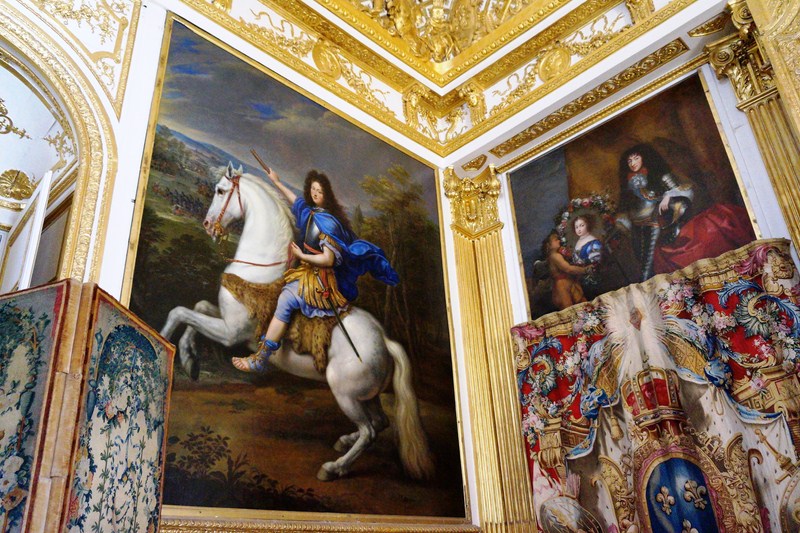
At left is the Equestrian painting of Philippe of France, Duke of Orléans (only brother of Louis XIV) by Pierre Mignard. Oil on canvas, 300 cm. (118.1 in.) by 261 cm. (102.7 in.)
The Council Room, adjacent to the King’s Chamber, opens onto the Hall of Mirrors. It took on its current in 1755, during the reign of Louis XV, when the King’s Cabinet (where Louis XIV held his council meetings) and the Cabinet des Termes (a more private space, where the king spent time with his family or certain guests after dinner) were combined.
The chamber is decorated with fine woodwork, based on drawings by Ange-Jacques Gabriel, and crafted by Antoine Rousseau. The elaborate motifs illustrate subjects, such as war and justice, addressed by the king during council meetings.
The decor also includes a Rococo-style clock (1754), a porphyry bust of Alexander the Great, and two vases of Mars and Minerva in Sevres porcelain and chased bronze by Pierre-Philippe Thomire (1787). The room, also used for official presentations (which were a necessary rite for admission to the Court), was where, on April 22, 1769, Madame Du Barry, among others, was presented to the King.
King’s Grand Apartment: First Floor, Chateau De Versailles, Place d’Armes, 78000 Versailles, France. Tel: +33 1 30 83 78 00. Website: www.chateauversailles.fr. Open daily (except on Mondays and May 1), from 9:00 AM to 6:30 PM. Last admission is 6 PM while the ticket office closes at 5.45 PM. The estate of Trianon and the Coach Gallery only open in the afternoon while the Park (7 AM to 8:30 PM) and Gardens (8 AM to 8.30 PM, last admission: 7 PM) are open every day. Access to the Gardens is free except on days of fountains shows. You can access the estate of Trianon through the Gardens or through the city. The Petit Trianon is only possible via the Grand Trianon.
Admission: 27 € for Passport with Timed Entry (days with Musical Fountains Shows or Musical Gardens), 20 € for Passport with Timed Entry (without musical fountains show or musical gardens), 12 € for Estate of Trianon ticket(without Musical Fountains Show or Musical Gardens), 10 € for Passport with Timed Entry (free admission, days with Musical Fountains Show or Musical Gardens), 9,50 € for Musical Fountains Show ticket, 8,50 € for Musical Gardens ticket, 28 € for the Fountains Night Show.
How to Get There: The cheapest option for reaching Versailles is by train. There are three train stations in Versailles. RER line C arrives at Versailles Château – Rive Gauche train station, the closest one of the Palace (just 10 minutes’ walk to the Palace). SNCF trains from Gare Montparnasse arrive at Versailles Chantiers train station, which is 18 minutes on foot to the Palace. SNCF trains from Gare Saint Lazare arrive at Versailles Rive Droite train station, 17 minutes on foot to the Palace. RER C and SNCF train times are available on www.transilien.com.
Versailles Palace – Hall of Mirrors (France)
The Hall of Mirrors (Galerie des Glaces), the most famous and emblematic room in the royal Palace of Versailles, is located on the ground floor of the palace’s central body, facing west towards the Palace Gardens. Located besides the Palace Chapel, it is flanked, at the far ends, by the Salon of War (Salon de la Guerre) in the north and the Salon of Peace (Salon de la Paix) in the south, respectively. The Hall of Mirror connects to the two salons, which were assigned to and incorporated into the king’s apartments (grand appartement du roi) in the north and the queen’s apartments (grand appartement de la reine) in the south.
Check out “Versailles Palace” and “Versailles Palace – Grand Gallery”
It was built, during the palace’s third building stage (between 1678 and 1684), to replace a large rooftop terrace designed by the architect Louis Le Vau, which originally stood between the King’s Apartments to the north and the Queen’s to the south and opened onto the garden. The terrace was awkward (it was considered to be a rather misplaced architectural element) and, above all, especially exposed to bad weather (which reduced its utility) and it was not long before the decision was made to quickly condemn and demolish it.
Jules Hardouin-Mansart, Le Vau’s successor, produced a more suitable design that replaced the terrace with the grand, Baroque-style Hall of Mirrors. He appropriated three rooms each from the King and the Queen’s apartment as well as the terrace that separated the two apartments.
The hall pays tribute to the political, economic and artistic success of France. The 30 painted compositions on the vaulted ceiling by artist Charles Le Brun (who created the interior decorative apparatus), illustrate the political successes by depicting the glorious history of Louis XIV during the first 18 years of his reign, starting with the Treaty of the Pyrenees (1659) to the Treaty of Nijmegen (1678–1679).
The allegories from Antiquity illustrate the military and diplomatic victories and reforms, with a view to reorganizing the kingdom. The number and size of the 357 mirrors (which, in the 17th century, were an expensive luxury product that could only be produced with great effort) bedecking the 17 arches opposite the windows, demonstrated that the new French manufacture, by the Manufacture royale de glaces de miroirs (later Compagnie de Saint-Gobain), a glass factory founded by Jean-Baptiste Colbert, could rival the Venetian monopoly on mirror manufacturing in Europe, thus revealing economic prosperity.
According to legend, the government of the Venetian Republic, in order to keep its monopoly, sent agents to France to poison the workers whom Colbert had brought to France.
The Rouge de Rance marble pilasters, topped with gilded bronze capitals based on a new design (which was referred to as “the French style”) and created by Le Brun upon the request of Colbert, showed artistic success.
The design, incorporating the national emblems, featured a fleur-de-lis topped by a royal sun between two Gallic roosters (the Latin word for rooster was gallus) or cockerels. Adorning the green marble Pier glasses are gilded bronze trophies manufactured by goldsmith Pierre Ladoyreau. In its heyday, over 3,000 candles were used to light the Hall of Mirrors.
Work on the Hall of Mirrors started in 1678 and ended in 1684, at which time it was pressed into use for court and state functions. Upon its completion, it served as a kind of covered promenade for Louis XIV’s visit to the chapel.
At least once a day, he entered the gallery and, from 1701, the king’s bedroom lay behind the middle wall of the gallery. Courtiers and visitors crossed the Hall of Mirrors daily and assembled there to watch the King walk from his apartments to the chapel with members of the royal family. Sometimes, they took the occasion to present him with requests.
In the successive reigns of Louis XV and Louis XVI, family and court functions, embassies, and births were held in this room. It also served as a place for waiting and meeting. On rare occasions, the central location and size of Hall of Mirrors was used, for an extra dash of lavishness and for entertainment, for ceremonies such as full-dress and masked balls and royal weddings. They include:
- The wedding of Louis Ferdinand and Maria Theresa of Spain(1645)
- The wedding of the Duke of Burgundy with Marie Adélaïde of Savoy (December 11 and 14, 1697)
- The wedding of Louis XVI and Marie Antoinette (May 16, 1770)
- The celebrated Yew Tree Ball (February 25, 1745) – during this costume ball, Louis XV (who was dressed as a yewtree) met Jeanne-Antoinette Poisson d’Étiolles (who was costumed as Diana, goddess of the hunt). Jeanne-Antoinette, better known to history as the Marquise de Pompadour, became Louis XV’s mistress.
Rarely has the show of power reached such a level of ostentation than during this time. Foreign audiences, under the scrutiny of the French Court (seated to either side on tiered seating), were granted here and dignitaries and ambassadors had to cross the full length of this gallery before they could reach the king.
During diplomatic receptions, the silver throne (usually located in the Salon of Apollo) was placed on a platform at the end of the hall near the Salon of Peace, whose arch was closed off. The audiences that transpired in this room include the following:
- The Doge of Genoa (1685)
- The Siamese Embassy (1685 to 1686) – the most opulent audience of them all. At this time, the Hall of Mirrors and the grand appartements were still decorated with its original silver furniture.
- Mehemet Reza Bey, ambassador of the Shah of Persia (February 1715)
- The embassy of King Mahmud I of Turkey (1742)
One of the largest rooms in the palace, the Hall of Mirrors is 73 m. (240 ft.) long, 10.50 m. (34.4 ft.) deep with a height of 12.30 m. (40.4 ft.) reaching to the Attic floor of the Corps de Logis.
The principal feature of this Mirror Hall is the 17 mirror-clad arches that reflect the 17 equally large, arcaded windows that overlook the gardens. The mirrors, composed of 357 individual mirror surfaces, aesthetically mirror the image of the garden and the exterior of the castle into the interior of the building. The square windows on the upper floor, which can be seen from the outside, only serve aesthetic purposes as there are no rooms inside.
According to a contemporary anecdote: the mirror surface furnishings of such large areas as the 17 arches has been the idea of architect Jules Hardouin-Mansart, who wanted to prevent Le Brun from having even more opportunities to impress Louis with his work.
The original solid silver furniture by LeBrun, famous at the time, was soon lost, particularly the large, gilded silver guéridons (tables) lining the hall which were, in 1689, melted down and coined by order of Louis XIV to finance the War of the League of Augsburg.
Those on display today were made in 1770 for the marriage of Louis XVI and Marie Antoinette, based on the moldings of earlier silver versions made that had been melted down. The 24 crystal chandeliers were hung only for special occasions. The Hall of Mirrors’ furniture was manufactured during the 19th century as most of the original furnishings were lost during the French Revolution
Besides the mirrors, the Hall’s grandeur is best perceived through the majesty of its vault whose nine large and numerous smaller ceiling paintings, by Charles Le Brun (the most prestigious scenes were painted on strengthened canvas and glued to the vault by Le Brun himself), are dedicated to the idolization of the Sun King, praising the political policies and military successes of the first 20 years of his reign.
The claim to absolute power is highlighted by the painting The King Governs Himself (Le roi gouverne par lui-même) which alludes to the establishment of the personal reign of Louis XIV in 1661.
It shows Louis XIV, facing the powers of Europe and turning away from his pleasures, to accept a crown of immortality from Glory, with the encouragement of Mars. Further topics include the Peace of Nijmegen and the Conquest of the Franche-Comté.
On display here are marble and porphyry busts of eight Roman emperors (Julius Caesar, Caligula, Claudius, etc.) plus statues of Greek and Roman deities and Muses, such as Bacchus, Venus of Troas, Modesty, Hermes, Urania, Nemesis and Diana of Versailles.
The latter is just a copy. The original, moved to the Louvre in 1798, was replaced by a Diana sculpted by René Frémin for the gardens of the Château de Marly. Upon the restoration of the Hall of Mirrors during 2004 to 2007 it was, in turn, replaced by a copy of the original Diana.
On a number of occasions, the Hall of Mirrors has been the scene of events of great historic significance. They include:
- On January 18, 1871, in a deeply humiliating ceremony at the conclusion of the Franco-Prussian War, Prussian king William I, led by Otto von Bismarck, was declared German emperor (thus establishing the German Empire) in the Hall of Mirrors by the assembled German princes and lords. The event greatly contributed to the further accretion of the Franco-German enmity.
- O June 28, 1919, the Treaty of Versailles, officially ending the World War I, was signed here by French Prime Minister Clemenceau to dismantle the German Empire.
Since then, the Hall of Mirrors remains reserved for official ceremonies and presidents of the French Republic have continued to receive official guests here. Among them were:
- The reception of US-President John Fitzgerald Kennedy and his wife by Charles De Gaulle
- The reception of the Shah of Iran Mohammad Reza Pahlavi by Valéry Giscard d’Estaing in 1974
- The invitation of representatives of the Group of Seven summit by President François Mitterrand from June 4 to 6, 1982.
Hall of Mirrors: Chateau De Versailles, Place d’Armes, 78000 Versailles, France. Tel: +33 1 30 83 78 00. Website: www.chateauversailles.fr. Open daily (except on Mondays and May 1), from 9:00 AM to 6:30 PM. Last admission is 6 PM while the ticket office closes at 5.45 PM. The estate of Trianon and the Coach Gallery only open in the afternoon while the Park (7 AM to 8:30 PM) and Gardens (8 AM to 8.30 PM, last admission: 7 PM) are open every day. Access to the Gardens is free except on days of fountains shows. You can access the estate of Trianon through the Gardens or through the city. The Petit Trianon is only possible via the Grand Trianon.
Admission: 27 € for Passport with Timed Entry (days with Musical Fountains Shows or Musical Gardens), 20 € for Passport with Timed Entry (without musical fountains show or musical gardens), 12 € for Estate of Trianon ticket(without Musical Fountains Show or Musical Gardens), 10 € for Passport with Timed Entry (free admission, days with Musical Fountains Show or Musical Gardens), 9,50 € for Musical Fountains Show ticket, 8,50 € for Musical Gardens ticket, 28 € for the Fountains Night Show.
How to Get There: The cheapest option for reaching Versailles is by train. There are three train stations in Versailles. RER line C arrives at Versailles Château – Rive Gauche train station, the closest one of the Palace (just 10 minutes’ walk to the Palace). SNCF trains from Gare Montparnasse arrive at Versailles Chantiers train station, which is 18 minutes on foot to the Palace. SNCF trains from Gare Saint Lazare arrive at Versailles Rive Droite train station, 17 minutes on foot to the Palace. RER C and SNCF train times are available on www.transilien.com
Versailles Palace – Grand Gallery (France)
The Grand Gallery (Grande Galerie) is a set of three highly decorated reception rooms, dedicated to the celebration of the political and military successes of Louis XIV, and used for important ceremonies, celebrations and receptions.The grandiose ensemble of the Hall of Mirrors, and the adjoining Salon of War and Salon of Peace, were intended to illustrate the power of the absolutist monarch Louis XIV.
Check out “Versailles Palace“
Both salons are accessible, via the Hall of Mirrors, through wide opening passageways. The Hall and the two Salons, identically furnished and decorated, form a stylistic and functional unit. The exterior walls of the Salons date from the time of Louis Le Vau‘s encasings of the old château. They were given their current appearance after the installation of the Hall of Mirrors by Jules Hardouin-Mansart.
The vaunted Hall of Mirrors (Galerie des Glaces), perhaps the most celebrated room in the château of Versailles, was the setting for many of the ceremonies of the French Court during the Ancien Régime. It has inspired numerous copies and renditions throughout the world and the Proclamation of the German Empire occurred here.
Check out “Versailles Palace – Hall of Mirrors”
The Salon of War (Salon de la Guerre), commemorating the victorious military campaign of Louis XIV against the Dutch, Spanish and Germans (which ended in 1678 with the peace treaties of Nijmegen), was begun by Jules Hardouin-Mansart (the First Architect to the King) in 1678 and its decoration was completed by Le Brun in 1686. Its walls are covered with marble panels decorated with six trophies of weapons in gilded bronze.
Its centerpiece, on the wall adjacent to the Apollo Room , is an enormous oval sculpted medallion, created by Antoine Coysevox, surmounted by two golden sculptures of Pheme and supported by two captives in chains huddle beneath it.
A bas-relief, in stucco, depicts Louis XIV on horseback, trampling on his enemies while crossing the Rhine in 1672. Beneath, concealing the opening of a false chimney of a fake fireplace, is the bas-relief of Clio, the Muse of History, recording the king’s great deeds and exploits for posterity.
The dome cupola ceiling represents, in the center, a personified depiction of France, armed, sitting on a cloud and surrounded by Victories, a portrait of Louis XIV adorning her shield.
In the arches are represented his three defeated enemies – Germany (represented by a kneeling eagle), Spain making threats with a roaring lion; and Holland overthrown on another lion. The fourth arch represents Bellona, the Goddess of War, in a rage of fury between Rebellion and Discord.
The Salon of Peace (Salon de la Paix), symmetrical to the Salon of War, contains the same marble panel decoration and chased trophies of weapons of gilded and chiseled bronzes. However, Le Brun decorated the cupola and arches to illustrate the role of France as the arbiter and peacemaker of Europe under Louis XV. The painting on the ceiling, Louis XV offering an olive branch to Europe by François Lemoyne, illustrates the theme of peace.
From the beginning of Louis XIV’s reign, this room was separated from the Hall of Mirrors by a movable partition and was considered part of the Queen’s Apartment, constituting the final room after the Queen’s Chamber. However, when required, the partition separating the room from the Hall of Mirrors was removed and the room formed part of the King’s State Apartment.
Each Sunday, during the reign of Louis XV, Marie Leszczyńska, the Queen, used this salon as a music room, organizing concerts of secular and religious music, playing an important role in musical life in Versailles and which were continued, during the subsequent reign, by Marie-Antoinette.
Hall of Mirrors: Chateau De Versailles, Place d’Armes, 78000 Versailles, France. Tel: +33 1 30 83 78 00. Website: www.chateauversailles.fr. Open daily (except on Mondays and May 1), from 9:00 AM to 6:30 PM. Last admission is 6 PM while the ticket office closes at 5.45 PM. The estate of Trianon and the Coach Gallery only open in the afternoon while the Park (7 AM to 8:30 PM) and Gardens (8 AM to 8.30 PM, last admission: 7 PM) are open every day. Access to the Gardens is free except on days of fountains shows. You can access the estate of Trianon through the Gardens or through the city. The Petit Trianon is only possible via the Grand Trianon.
Admission: 27 € for Passport with Timed Entry (days with Musical Fountains Shows or Musical Gardens), 20 € for Passport with Timed Entry (without musical fountains show or musical gardens), 12 € for Estate of Trianon ticket(without Musical Fountains Show or Musical Gardens), 10 € for Passport with Timed Entry (free admission, days with Musical Fountains Show or Musical Gardens), 9,50 € for Musical Fountains Show ticket, 8,50 € for Musical Gardens ticket, 28 € for the Fountains Night Show.
How to Get There: The cheapest option for reaching Versailles is by train. There are three train stations in Versailles. RER line C arrives at Versailles Château – Rive Gauche train station, the closest one of the Palace (just 10 minutes’ walk to the Palace). SNCF trains from Gare Montparnasse arrive at Versailles Chantiers train station, which is 18 minutes on foot to the Palace. SNCF trains from Gare Saint Lazare arrive at Versailles Rive Droite train station, 17 minutes on foot to the Palace. RER C and SNCF train times are available on www.transilien.com.

